Climate-Oceans Emergency Response
DECLARE THE GLOBAL CLIMATE CHANGE PLANETARY EMERGENCY
Since at least 2007, we have known that the only response to the climate change emergency is a planetary emergency response.
Yet incredibly there is only one researched proposed plan, which is Plan B.4 by Lester Brown of Earth Policy Institute. It is free online with updates. This plan is an emergency response.
No other proposals are emergency responses, because they all take 50 years to stabilize atmospheric CO2.
We need a drastic global emergency response now for survival and we need to prepare to respond to the environmental and population health catastrophes that are now unavoidable because of our already committed global climate change.
Fossil fuel elimination
For one example, contraction and convergence is a popular approach, but it is not an emergency response and it does not eliminate fossil fuels. We have known for many years that the only emissions response is a zero carbon response.
Conversion
Conversion is the key. We must and can convert today's GHG-polluting goods and services to alternatives that do not emit.
All GHGs
We have known for many years that we have several times more than enough zero-carbon renewable energy available.
We know we must stop sources of black carbon soot emissions (which are second only to CO2 for warming). We must stop sources of nitrous oxide emissions that last 115 years in the atmosphere. We must stop sources of methane, which has increased in the atmosphere 2.5 times. "Pathways that are likely to limit warming to below 2°C relative to pre-industrial levels [...] would require substantial emissions reductions over the next few decades and near zero emissions of carbon dioxide and other long-lived greenhouse gases by the end of the century." (AR5 SYN SPM Headline Statements)
There are three general reasons for declaring an emergency and they both apply to the unprecedented extent right now of global warming and climate change:
All long atmospheric lasting industrial greenhouse gas emissions must be stopped or virtually stopped. It is well established by carbon cycle and CO2 science that ONLY ZERO CARBON emissions energy production and use can stabilize global temperature and for that matter ocean acidification.
The second IPCC assessment 1995 recorded that due to the extremely long life time of nitrous oxide (N2O 315 years) its emissions would have to be virtually eliminated like CO2. How ever this has been forgotten with all the attention being focused on CO2.
Though methane lasts in the atmosphere for 15 years it is still classified as a long lasting GHG because 15 years is a very long time for a methane emission to last with its much greater global warming effect (72X CO2 over a 20 year period).
Some manufactured chemicals are such extremely powerful GHGs and so extremely last lasting that their emissions must be totally eliminated. This applied to the halocarbons and notably to sulfur hexafloride (SF6) an industrial pollutant which is the most powerful long lasting of all GHGs.
While it is well esatblished in the science that we must have zero carbo emissions there is no zero carbon policy proposal. Also we must have a zero long lasting GHG emissions plan but this is not recorded in the published science so is not being considered at all.
Zero carbon emissions plan
Zero carbon emissions is what the science dictates and means no more carbon being added to the atmosphere by human activities.
The best we can do is virtual zero (usually meaning over a 90% global reduction) because just growing our food in the most climate friendly way has to emit some carbon. In order to meet climate science requirement of actual zero carbon some CO2 must be extracted and secured from the atmosphere. In theory this can be done by increasing the natural carbon sink, developing artificial carbon sinks and by technology to remove CO2 from the air. Nano technology has been suggested as another approach to remove CO2 from the air. None of these have been developed past prototype.
Virtual zero carbon emissions means a total world wide conversion of all fossil fuel energy with clean zero carbon energy sources. Fossil fuel energy must be replaced by zero carbon energy. The present approach is to only reduce carbon intensity, or burn less fossil fuels more efficiently. This can never get near global zero carbon emissions and in fact allows the fossil fuel industry to keep developed nations fossil fuel dependent and keep globalizing fossil fuel energy, on the rationale that the highly polluting world manufacturing base in Asia will eventually reduce its pollution.
The same principles of conversion and replacement apply to the other long lasting GHG emissions.
Black Carbon BC (soot)
Research published 2013 confirms a previous finding that black carbon emissions or soot is second only to CO2 in causing global warming. This is due to the direct atmospheric warming of black carbon particles and their effect in reducing Far North and Arctic snow albedo cooling.
Because fossil fuel combustion is the main source of black carbon this reinforces the urgent need to stop burning fossil fuels. Diesel is the worst fossil fuel source though burning kerosene in the developing world is a big source.
In a zero carbon emissions plan black carbon emissions from burning fossil fuels would eliminated.
Methane emissions
Methane is the second or third global warming agent depending on the inclusion of black carbon.
Though it doesn't last as long as CO2 inthe atmosphere as CO2 (15 years compared to 100 years) over a period of 20 years methane meissions have 72 times the global warming effect as CO2, so clearly methane emissions have to stopped to stop the global temperature increasing.
Sources of methane emissions:
These can all be converted to non methane emitting goods and services.
It is not as easy to full cost methane emissions as CO2. However because meat is an established cause of human disease this social cost of the largest source of methane emissions can be costed.
Methane and other non CO2 gases that last less time in the atmosphere than CO2 are being promoted as an easier and fast acting mitigation approach, while governments continue to negotiate a treaty ( and delay action) on CO2 emissions.
In 2000 James Hansen published a paper Global warming in the twenty-first century: An alternative scenario. In this paper he suggested rapid action on cutting non CO2 emissions of methane, tropospheric (ground level) ozone, halo carbons and black carbon. He pointed out that because a substantial part of fossil fuel CO2 warming is offset by fossil fuel air pollution cooling aerosols the sources of non CO2 emissions may have had a larger global warming effect that the science has estimated.
"A common view is that the current global warming rate will continue or accelerate. But we argue that rapid warming in recent decades has been driven mainly by non-CO2 greenhouse gases (GHGs), such as chlorofluorocarbons, CH4, and N2O, not by the products of fossil fuel burning, CO2 and aerosols, the positive and negative climate forcings of which are partially offsetting. ... If sources of CH4 and O3 (ozone) precursors were reduced in the future, the change in climate forcing by non-CO2 GHGs in the next 50 years could be near zero. Combined with a reduction of black carbon emissions and plausible success in slowing CO2 emissions, this reduction of non-CO2 GHGs could lead to a decline in the rate of global warming, reducing the danger of dramatic climate change. Such a focus on air pollution has practical benefits that unite the interests of developed and developing countries."
Global warming in the twenty-first century: An alternative scenario James Hansen PNAS 2000
Nitrous oxide
Though emissions of nitrous oxide have not caused as much global warming as CO2 or methane it an extremely powerful (290 X CO2) and extremely long lasting GHG (115 years), so emissions must be stopped to stabilize the global temperature.
The main source of nitrous oxide emissions agricultural use of nitrogen chemical fertilizer. It is also produced by the livestock industry and fossil fuel combustion.
Converting off fossil fuels and converting off meat eating would eliminate these two N2O sources and reinforces the urgent need for us to make these societal societies, that would both benefit our personal health by the way.
Farmers use far more chemical nitrogen fertilizer that is needed, so its use can be rapidly reduced. Converting off chemical fertilizers back to natural fertilizers in the only way forward on N2O emissions and the success of organic farming proves this can be done.
Tropospheric (ground level) ozone
Ground level ozone is the well known air pollutant that is a respiratory tract toxin in minute amounts. It is another greenhouse formed as result of fossil fuel polluting chemicals reacting with sun light. As the temperature rises so does the amount of
ground level ozone. It is mostly formed in the industrial Northern hemisphere.
It is a short lasting GHG in the atmosphere.
A zero carbon switch off all fossil fuels will also eliminate this GHG, and clean up the air pollution.
It has an extra global warming feedback effect. Because it is toxic to green plants reducing their photosythesis capacity of absorbing carbon from CO2 in the air, an increase in tropospheric ozone will act as a feedback increasing the atmospheric CO2.
Since at least 2007, we have known that the only response to the climate change emergency is a planetary emergency response.
Yet incredibly there is only one researched proposed plan, which is Plan B.4 by Lester Brown of Earth Policy Institute. It is free online with updates. This plan is an emergency response.
No other proposals are emergency responses, because they all take 50 years to stabilize atmospheric CO2.
We need a drastic global emergency response now for survival and we need to prepare to respond to the environmental and population health catastrophes that are now unavoidable because of our already committed global climate change.
Fossil fuel elimination
For one example, contraction and convergence is a popular approach, but it is not an emergency response and it does not eliminate fossil fuels. We have known for many years that the only emissions response is a zero carbon response.
Conversion
Conversion is the key. We must and can convert today's GHG-polluting goods and services to alternatives that do not emit.
All GHGs
We have known for many years that we have several times more than enough zero-carbon renewable energy available.
We know we must stop sources of black carbon soot emissions (which are second only to CO2 for warming). We must stop sources of nitrous oxide emissions that last 115 years in the atmosphere. We must stop sources of methane, which has increased in the atmosphere 2.5 times. "Pathways that are likely to limit warming to below 2°C relative to pre-industrial levels [...] would require substantial emissions reductions over the next few decades and near zero emissions of carbon dioxide and other long-lived greenhouse gases by the end of the century." (AR5 SYN SPM Headline Statements)
There are three general reasons for declaring an emergency and they both apply to the unprecedented extent right now of global warming and climate change:
- Unprecedented disasters are already happening on all continents and are so severe for the human population that only immediate action with focused multiple resources can mitigate severe suffering and loss of life for billions of people
- Planetary calamity can be expected due to feedback runaway global heating and climate chaos, plus oceans collapse from ocean heating, acidification and de-oxygenation.
- The world is already committed (locked-in) to a much greater degree of global climate and ocean disruption.
It is not realized that the declaration of a global climate planetary emergency is the first response to the global climate change crisis.
It goes without saying that we all need to reduce our carbon footprint and many organizations have been working on that for many years. However, lifestyle changes cannot result in a zero carbon world so long as we are kept dependent on fossil fuels for energy.
FIX THE PERVERSE ECONOMICS
The cause of global climate change and ocean acidification is economic (market failures) and there can be no end to GHG pollution without correcting the economics. As Lester Brown says our economics does not tell the economic truth. It is biased towards industrial activities that cause resource depletion and pollution.
It goes without saying that we all need to reduce our carbon footprint and many organizations have been working on that for many years. However, lifestyle changes cannot result in a zero carbon world so long as we are kept dependent on fossil fuels for energy.
FIX THE PERVERSE ECONOMICS
The cause of global climate change and ocean acidification is economic (market failures) and there can be no end to GHG pollution without correcting the economics. As Lester Brown says our economics does not tell the economic truth. It is biased towards industrial activities that cause resource depletion and pollution.
Eliminate all GHG polluting subsidies
The obvious first step (emergency or not) is to eliminate all subsidies to the GHG polluting industries. In the case of fossil fuels these amount to trillions of dollars world wide (IMF). Stop all fossil fuel subsidies and switch the amount to aid the rapid development of clean zero carbon energy. The 2014 IMF report found fossil fuel subsidies world wide amount to over $5 Trillion even than its 2013 estimate of $1.9 trillion (2013 report).
The 2006 Stern Commission report provided the best brief list of measures for avoiding planetary catastrophe headed by First put a price on price carbon. The pricing method favoured by N Stern and most economists is the carbon tax. This does not preclude other measures like capping emissions with regulation and carbon trading, but only governments charging the polluter at source for the costs of pollution can reliably and rapidly shift investment money out of fossil fuels and into zero carbon renewables.
Correcting climate change market failure by internalizing the full externalized costs of GHG pollution
The Stern Commission report showed how the correction of the market failure that results in GHG emissions pollution can be corrected in accordance with modern market economics, by identifying the single root of cause of global climate change. Calling global climate change the greatest and most wide reaching market failure ever Stern said the externalized costs of carbon pollution can and must be internalized.
This principle applies to all GHG emissions.
The Commission advised three strands to policy: all are required.
Policy to reduce emissions should be based on three essential elements:
For fossil fuel CO2 mitigation should be no big problem in correcting the market so that funds leave the fossil fuel industries for the clean zero carbon industries.
Fossil fuel subsidies have been calculated and are up to a two trillion dollars (or more).
Externalized costs can be internalized because the socio-environmental costs are known (air, water pollution, and GHGs) and have been calculated. Recent calculations include some accounting for global climate change.
The obvious first step (emergency or not) is to eliminate all subsidies to the GHG polluting industries. In the case of fossil fuels these amount to trillions of dollars world wide (IMF). Stop all fossil fuel subsidies and switch the amount to aid the rapid development of clean zero carbon energy. The 2014 IMF report found fossil fuel subsidies world wide amount to over $5 Trillion even than its 2013 estimate of $1.9 trillion (2013 report).
The 2006 Stern Commission report provided the best brief list of measures for avoiding planetary catastrophe headed by First put a price on price carbon. The pricing method favoured by N Stern and most economists is the carbon tax. This does not preclude other measures like capping emissions with regulation and carbon trading, but only governments charging the polluter at source for the costs of pollution can reliably and rapidly shift investment money out of fossil fuels and into zero carbon renewables.
Correcting climate change market failure by internalizing the full externalized costs of GHG pollution
The Stern Commission report showed how the correction of the market failure that results in GHG emissions pollution can be corrected in accordance with modern market economics, by identifying the single root of cause of global climate change. Calling global climate change the greatest and most wide reaching market failure ever Stern said the externalized costs of carbon pollution can and must be internalized.
This principle applies to all GHG emissions.
The Commission advised three strands to policy: all are required.
Policy to reduce emissions should be based on three essential elements:
- First, we must establish a carbon price via tax, trade and regulation – without this price there is no incentive to de- carbonize.
- Second, we must promote technology: through research and development. Further, private sector investors need confidence that there will be markets for their products: that is why deployment policy also makes sense.
-
And third we must deal with market failure; for example problems in property and capital markets inhibit investments for energy-efficiency. Further, the sticks and carrots of incentives, rightly emphasized by we economists, need to be supported by information. And still further, greater understanding of the issues can itself change the behavior of individuals and firms.
The Stern Commission report focused on CO2 like most other climate change mitigation proposals, because CO2 lasts so long in the atmosphere (20% 1000 years) that its impacts are practically irreversible and it has contributed most to global warming. However only changing CO emissions will not stabilize global temperature, because of other long lasting and very powerful GHG emissions.
The Stern Commission also referred to switching to a low carbon economy as most proposed plans do. This is far too vague for a carbon emissions goal and is practice is being used as a lower carbon economy that is far off a virtual zero economy.
ZERO/VIRTUAL ZERO CARBON AND LONG LASTING GHG EMISSIONSThe Stern Commission also referred to switching to a low carbon economy as most proposed plans do. This is far too vague for a carbon emissions goal and is practice is being used as a lower carbon economy that is far off a virtual zero economy.
For fossil fuel CO2 mitigation should be no big problem in correcting the market so that funds leave the fossil fuel industries for the clean zero carbon industries.
Fossil fuel subsidies have been calculated and are up to a two trillion dollars (or more).
Externalized costs can be internalized because the socio-environmental costs are known (air, water pollution, and GHGs) and have been calculated. Recent calculations include some accounting for global climate change.
All long atmospheric lasting industrial greenhouse gas emissions must be stopped or virtually stopped. It is well established by carbon cycle and CO2 science that ONLY ZERO CARBON emissions energy production and use can stabilize global temperature and for that matter ocean acidification.
The second IPCC assessment 1995 recorded that due to the extremely long life time of nitrous oxide (N2O 315 years) its emissions would have to be virtually eliminated like CO2. How ever this has been forgotten with all the attention being focused on CO2.
Though methane lasts in the atmosphere for 15 years it is still classified as a long lasting GHG because 15 years is a very long time for a methane emission to last with its much greater global warming effect (72X CO2 over a 20 year period).
Some manufactured chemicals are such extremely powerful GHGs and so extremely last lasting that their emissions must be totally eliminated. This applied to the halocarbons and notably to sulfur hexafloride (SF6) an industrial pollutant which is the most powerful long lasting of all GHGs.
While it is well esatblished in the science that we must have zero carbo emissions there is no zero carbon policy proposal. Also we must have a zero long lasting GHG emissions plan but this is not recorded in the published science so is not being considered at all.
Zero carbon emissions plan
Zero carbon emissions is what the science dictates and means no more carbon being added to the atmosphere by human activities.
The best we can do is virtual zero (usually meaning over a 90% global reduction) because just growing our food in the most climate friendly way has to emit some carbon. In order to meet climate science requirement of actual zero carbon some CO2 must be extracted and secured from the atmosphere. In theory this can be done by increasing the natural carbon sink, developing artificial carbon sinks and by technology to remove CO2 from the air. Nano technology has been suggested as another approach to remove CO2 from the air. None of these have been developed past prototype.
Virtual zero carbon emissions means a total world wide conversion of all fossil fuel energy with clean zero carbon energy sources. Fossil fuel energy must be replaced by zero carbon energy. The present approach is to only reduce carbon intensity, or burn less fossil fuels more efficiently. This can never get near global zero carbon emissions and in fact allows the fossil fuel industry to keep developed nations fossil fuel dependent and keep globalizing fossil fuel energy, on the rationale that the highly polluting world manufacturing base in Asia will eventually reduce its pollution.
The same principles of conversion and replacement apply to the other long lasting GHG emissions.
Black Carbon BC (soot)
Research published 2013 confirms a previous finding that black carbon emissions or soot is second only to CO2 in causing global warming. This is due to the direct atmospheric warming of black carbon particles and their effect in reducing Far North and Arctic snow albedo cooling.
Because fossil fuel combustion is the main source of black carbon this reinforces the urgent need to stop burning fossil fuels. Diesel is the worst fossil fuel source though burning kerosene in the developing world is a big source.
In a zero carbon emissions plan black carbon emissions from burning fossil fuels would eliminated.
Methane emissions
Methane is the second or third global warming agent depending on the inclusion of black carbon.
Though it doesn't last as long as CO2 inthe atmosphere as CO2 (15 years compared to 100 years) over a period of 20 years methane meissions have 72 times the global warming effect as CO2, so clearly methane emissions have to stopped to stop the global temperature increasing.
Sources of methane emissions:
- livestock industry,
- paddy field rise production,
- land fills,
- fugitive (leaks) from natural gas, and
- fossil fuel combustion.
These can all be converted to non methane emitting goods and services.
It is not as easy to full cost methane emissions as CO2. However because meat is an established cause of human disease this social cost of the largest source of methane emissions can be costed.
Methane and other non CO2 gases that last less time in the atmosphere than CO2 are being promoted as an easier and fast acting mitigation approach, while governments continue to negotiate a treaty ( and delay action) on CO2 emissions.
In 2000 James Hansen published a paper Global warming in the twenty-first century: An alternative scenario. In this paper he suggested rapid action on cutting non CO2 emissions of methane, tropospheric (ground level) ozone, halo carbons and black carbon. He pointed out that because a substantial part of fossil fuel CO2 warming is offset by fossil fuel air pollution cooling aerosols the sources of non CO2 emissions may have had a larger global warming effect that the science has estimated.
"A common view is that the current global warming rate will continue or accelerate. But we argue that rapid warming in recent decades has been driven mainly by non-CO2 greenhouse gases (GHGs), such as chlorofluorocarbons, CH4, and N2O, not by the products of fossil fuel burning, CO2 and aerosols, the positive and negative climate forcings of which are partially offsetting. ... If sources of CH4 and O3 (ozone) precursors were reduced in the future, the change in climate forcing by non-CO2 GHGs in the next 50 years could be near zero. Combined with a reduction of black carbon emissions and plausible success in slowing CO2 emissions, this reduction of non-CO2 GHGs could lead to a decline in the rate of global warming, reducing the danger of dramatic climate change. Such a focus on air pollution has practical benefits that unite the interests of developed and developing countries."
Global warming in the twenty-first century: An alternative scenario James Hansen PNAS 2000
Nitrous oxide
Though emissions of nitrous oxide have not caused as much global warming as CO2 or methane it an extremely powerful (290 X CO2) and extremely long lasting GHG (115 years), so emissions must be stopped to stabilize the global temperature.
The main source of nitrous oxide emissions agricultural use of nitrogen chemical fertilizer. It is also produced by the livestock industry and fossil fuel combustion.
Converting off fossil fuels and converting off meat eating would eliminate these two N2O sources and reinforces the urgent need for us to make these societal societies, that would both benefit our personal health by the way.
Farmers use far more chemical nitrogen fertilizer that is needed, so its use can be rapidly reduced. Converting off chemical fertilizers back to natural fertilizers in the only way forward on N2O emissions and the success of organic farming proves this can be done.
Tropospheric (ground level) ozone
Ground level ozone is the well known air pollutant that is a respiratory tract toxin in minute amounts. It is another greenhouse formed as result of fossil fuel polluting chemicals reacting with sun light. As the temperature rises so does the amount of
ground level ozone. It is mostly formed in the industrial Northern hemisphere.
It is a short lasting GHG in the atmosphere.
A zero carbon switch off all fossil fuels will also eliminate this GHG, and clean up the air pollution.
It has an extra global warming feedback effect. Because it is toxic to green plants reducing their photosythesis capacity of absorbing carbon from CO2 in the air, an increase in tropospheric ozone will act as a feedback increasing the atmospheric CO2.
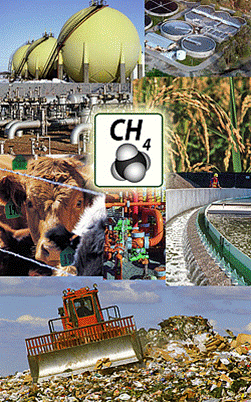
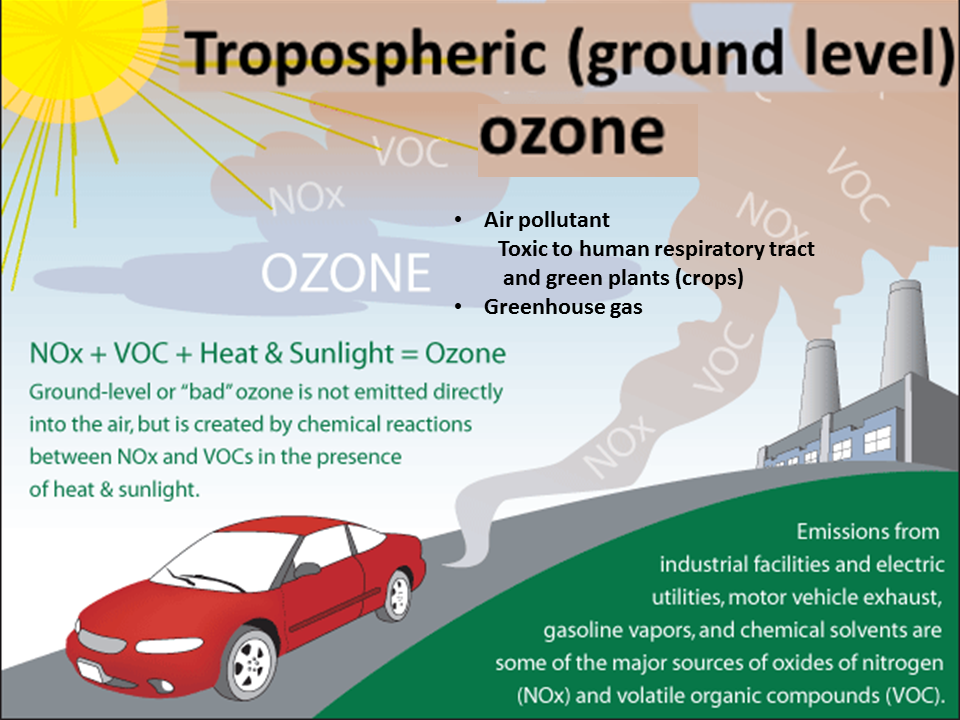
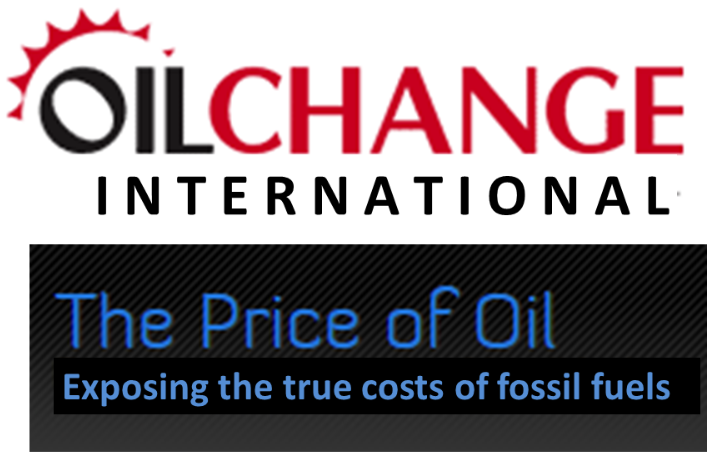
The most effective solution is simple, readily applicable and rapidly acting.
1. STOP ALL GREENHOUSE GAS POLLUTING SUBSIDIES
2. CHARGE INDUSTRY THE FULL COST OF THEIR POLLUTION
There is general agreement in favour of both the above over many years, going back to the 1992 UN Rio Earth summit agreements.
In 2009 the G20 agreed to phase out fossil out subsidies. In May 2016 the G7 promised a phase out by 2025, which is just another delay.
ACT ON the $100Billion/YR. PLEDGE TO ASSIST MOST VULNERABLE NATIONS
This is a 2010 pledge for 2020 by Annex nations to meet financial obligations under the
1992 UNFCCC, but the most vulnerable nations need more of the assistance now,
which is still holding up an agreement.
Climate Charge levied on large central polluters the cost of their pollution
The IPCC AR5 - emissions must decline fast from 2020 at the latest (RCP2.6).
June 2014 report by REMI finds that a revenue carbon tax creates jobs and grows the economy.
Economists prefer a carbon tax which is really a pollution charge, and the amount is an increasing annual charge rising to about $125 a tone CO2. 2008 B. Andrews Wiley Market failure, govt failure and externalities .. case for a carbon tax. The IPCC AR4 WG3 finds that climate change cost estimates 'run from US$-10 to US$+350 per tonne of carbon' and that meeting the 2 degrees target: about 100 US$/tCO2eq carbon price needed by 2030' Costs of carbon.
A June 2014 economics paper from the Research Institute on Climate Change and the EnvironmentA global carbon price of at least $32 per tonne is needed by 2015 to apply an effective brake on global warming rising to $82-260/tCO2 within 20 years.
Though these market failure corrections should work powerfully and rapidly, the global climate planetary emergency is now so dire that a massive international joint venture on a global Manhattan or Apollo scale is called for.
Yet we actually have no global or international plan to bring down or stabilize atmospheric GHG concentrations or even to reverse the continually increasing GHG emissions, which is total insanity.
GHG pollution promoting subsides.There is one response that would predictably and rapidly drive investment away from more fossil fuel extraction and into clean energy. That is governments stopping greenhouse gas pollution promoting subsidies. In fact without stopping the fossil fuel subsidies ($1.9Trillion IMF 2013) our only future is planetary catastrophe.
In 2006 the UK Stern Commission Economics of Climate Change report showed the way and a short version of the plan takes up only a page.
One recommendation of the Stern Commission plan was a government public 'education and persuasion' ongoing project. Article 6 of the UN FCCCC (climate convention) requires governments to 'promote' 'facilitate' and 'develop' climate chnaghe education at all levels.
However like practically all the climate change mitigation proposals from all sectors of society the Stern Commission de-carbonization relies on carbon capture storage (CCS). There is no evidence CCS can work and if it did it could not possibly handle all the CO2 emissions from the worlds power plants, nor could it work to any extent for long. Though research is warranted no climate change mitigation plan can or need rely on CCS. Clean zero carbon energy can replace all the world's fossil fuel energy many times over. The Stern report remains important because it did identify the key aspects required to avoid planetary catastrophe.
Climate feedback expert David Wasdell calls his proposal The Apollo-Gaia Project which he called for years ago.
Lester Brown of Earth Policy Institute calls his Plan B4 Mobilizing to save civilization and he calls for a war time speed rapid response. Incredibly, his response is the only comprehensive climate emergency plan that we have.
The most certain effective measure is to stop GHG polluting subsidies and internalize the full costs of GHG pollution.
1. STOP ALL GREENHOUSE GAS POLLUTING SUBSIDIES
2. CHARGE INDUSTRY THE FULL COST OF THEIR POLLUTION
There is general agreement in favour of both the above over many years, going back to the 1992 UN Rio Earth summit agreements.
In 2009 the G20 agreed to phase out fossil out subsidies. In May 2016 the G7 promised a phase out by 2025, which is just another delay.
ACT ON the $100Billion/YR. PLEDGE TO ASSIST MOST VULNERABLE NATIONS
This is a 2010 pledge for 2020 by Annex nations to meet financial obligations under the
1992 UNFCCC, but the most vulnerable nations need more of the assistance now,
which is still holding up an agreement.
Climate Charge levied on large central polluters the cost of their pollution
The IPCC AR5 - emissions must decline fast from 2020 at the latest (RCP2.6).
June 2014 report by REMI finds that a revenue carbon tax creates jobs and grows the economy.
Economists prefer a carbon tax which is really a pollution charge, and the amount is an increasing annual charge rising to about $125 a tone CO2. 2008 B. Andrews Wiley Market failure, govt failure and externalities .. case for a carbon tax. The IPCC AR4 WG3 finds that climate change cost estimates 'run from US$-10 to US$+350 per tonne of carbon' and that meeting the 2 degrees target: about 100 US$/tCO2eq carbon price needed by 2030' Costs of carbon.
A June 2014 economics paper from the Research Institute on Climate Change and the EnvironmentA global carbon price of at least $32 per tonne is needed by 2015 to apply an effective brake on global warming rising to $82-260/tCO2 within 20 years.
Though these market failure corrections should work powerfully and rapidly, the global climate planetary emergency is now so dire that a massive international joint venture on a global Manhattan or Apollo scale is called for.
Yet we actually have no global or international plan to bring down or stabilize atmospheric GHG concentrations or even to reverse the continually increasing GHG emissions, which is total insanity.
GHG pollution promoting subsides.There is one response that would predictably and rapidly drive investment away from more fossil fuel extraction and into clean energy. That is governments stopping greenhouse gas pollution promoting subsidies. In fact without stopping the fossil fuel subsidies ($1.9Trillion IMF 2013) our only future is planetary catastrophe.
In 2006 the UK Stern Commission Economics of Climate Change report showed the way and a short version of the plan takes up only a page.
One recommendation of the Stern Commission plan was a government public 'education and persuasion' ongoing project. Article 6 of the UN FCCCC (climate convention) requires governments to 'promote' 'facilitate' and 'develop' climate chnaghe education at all levels.
However like practically all the climate change mitigation proposals from all sectors of society the Stern Commission de-carbonization relies on carbon capture storage (CCS). There is no evidence CCS can work and if it did it could not possibly handle all the CO2 emissions from the worlds power plants, nor could it work to any extent for long. Though research is warranted no climate change mitigation plan can or need rely on CCS. Clean zero carbon energy can replace all the world's fossil fuel energy many times over. The Stern report remains important because it did identify the key aspects required to avoid planetary catastrophe.
Climate feedback expert David Wasdell calls his proposal The Apollo-Gaia Project which he called for years ago.
Lester Brown of Earth Policy Institute calls his Plan B4 Mobilizing to save civilization and he calls for a war time speed rapid response. Incredibly, his response is the only comprehensive climate emergency plan that we have.
The most certain effective measure is to stop GHG polluting subsidies and internalize the full costs of GHG pollution.

CLIMATE SYSTEM EMERGENCY INSTITUTE
The Health and Human Rights Approach to Climate Change
The Health and Human Rights Approach to Climate Change
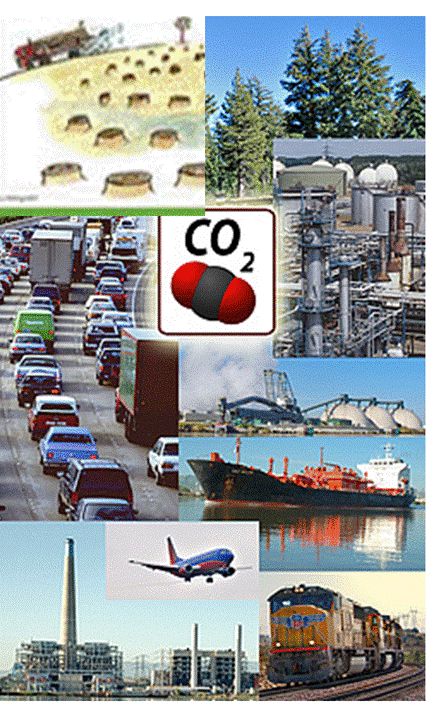
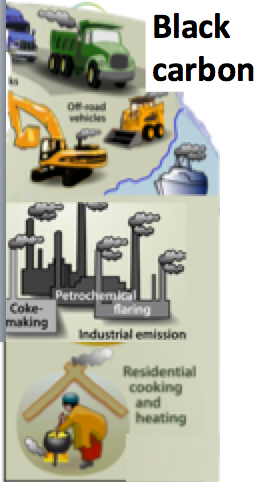
STOP DEFORESTATION
PROTECT THE LAND CARBON SINK
AFFORESTATION
STOP DEEP SEA TRAWLING
PROTECT THE OCEAN CARBON SINK
PROTECT THE LAND CARBON SINK
AFFORESTATION
STOP DEEP SEA TRAWLING
PROTECT THE OCEAN CARBON SINK
Recent Research
by date
12 Feb 2021 The global race to produce hydrogen offshore
14 Jan 2021 Putting the brakes on climate change – it’s about more than just CO2.
7 Dec 2020 Hard and fast emission cuts slow warming in the next 20 years
Dec 2020 Net Zero for America slides
1 Dec 2020 costs of planting, preserving, managing forests to mitigate
by date
12 Feb 2021 The global race to produce hydrogen offshore
14 Jan 2021 Putting the brakes on climate change – it’s about more than just CO2.
7 Dec 2020 Hard and fast emission cuts slow warming in the next 20 years
Dec 2020 Net Zero for America slides
1 Dec 2020 costs of planting, preserving, managing forests to mitigate
climate change
Nov 2020 (US by 2050) Carbon‐Neutral Pathways for the United States
Nov 2020 (US by 2050) Carbon‐Neutral Pathways for the United States
24 Nov 2020 Restoration
of degraded grasslands..
31 Aug 2020 Fossil fuels face rapid defeat by UK’s wind and sun By 2025
24 Aug 2020 Negative emissions technologies may not solve climate crisis
8 June 2020 US can reach 90 percent clean electricity by 2035, dependably and without increasing consumer bills Paper
24 Nov 2020 Restoration
of degraded grasslands..
31 Aug 2020 Fossil fuels face rapid defeat by UK’s wind and sun By 2025
24 Aug 2020 Negative emissions technologies may not solve climate crisis
8 June 2020 US can reach 90 percent clean electricity by 2035, dependably and without increasing consumer bills Paper
2 April 2020
Smaller scale solutions needed for rapid progress towards emissions targets
2 April 2020
Best path to net zero: Cut short-lived super-pollutants
4 March 2020 Tropical forest carbon sink are failing, requiring faster CO2 emissions cuts.
4 March 2020 Tropical forest carbon sink are failing, requiring faster CO2 emissions cuts.
16 March 2020 Replenishing and protecting the world’s soil carbon stores could help to offset up to 5.5bn tonnes of greenhouse gases every year
10 March 2020 London pioneers the city’s first ‘virtual power station’ (store off peak energy)
30 Jan 2020 Can wood construction transform cities from carbon source to carbon vault?
20 Dec 2019 COP25 Wuppertal Institute
20 Dec 2019 M. Jacobson Energy Plans on Grid
Stability, Costs, Jobs, Health, and Climate in 143
Countries
Stability, Costs, Jobs, Health, and Climate in 143
Countries
16 Dec 2019 Halting climate change means a world without fossil fuels—not merely curbing emissions
Nov 2019 Soil carbon science for policy and practice (carbon sinking ?)
2019 WRI The Ocean as
a Solution to
Climate Change
a Solution to
Climate Change
Oct 2019 IEA CO2 emissions from fossil fuel combustion
October 28 2019 US Phoenix project sets world record for strongest nuclear fusion reaction
25 Oct 2019 The Health and Climate Impacts of Carbon Capture Mark Jacobson Low capture, air pollutn PDF
25 Oct 2019 The Health and Climate Impacts of Carbon Capture Mark Jacobson Low capture, air pollutn PDF
24 Oct 2019 MIT engineers develop a new way to remove CO2 from air
Oct 2019 IEA Offshore Wind potential to over 420 000 TWh per year =18X world electricity
21 Oct 2019
Contribution of the land sector to a 1.5 °C world (potential 30% of CO2 reductions)
4 July 2019 Adding 1 billion hectares of forest could help check global warming
June 2019 IEA
The Future of Hydrogen
June 2019 What can I do?
April 2019 Robust abatement pathways to tolerable climate require immediate global action (even economics)
April 2019 Robust abatement pathways to tolerable climate require immediate global action (even economics)
20 March 2019 CO2 to coal
19 Mar 2019 Insulating transparent wood
25 Feb 2019 An appetite for destruction Nature
11 Feb 2019 Flags that generate energy from wind and sun
16 Jan 2019 Lancet EAT world diet
Jan 2019 Black carbon Profitably Fix Half of the Global Warming Problem and Save 2.4 Million Lives per Year
Jan 2019 Black carbon Profitably Fix Half of the Global Warming Problem and Save 2.4 Million Lives per Year
Nov 2018 Soil carbon sequestration is an elusive climate mitigation tool
30 Oct 2018 Geoengineering is no closer to working
29 Oct 2018 Osmotic power
24 Oct 2018 Europe National Academies negative emissions technologies-sequestration
16 Oct 2018 Can forests save us from climate change? worse if not treated well but No
10 Sept 2018 Solar power: Golden sandwich could make the world more sustainable
7 Sept 2018 Climate model shows large-scale wind and solar farms in the Sahara increase rain and vegetation
30 Aug 2018 The point of no return "negative emissions can offer a brief respite but only delay the PNR by a few years, not taking into account the possible decrease in effectiveness of these measures in the long term"
May 2017 The limits to global-warming mitigation by terrestrial carbon removal Biomass combustion capture for CO2 not feasible
April 2017 Carbon Dioxide Removal Options:
A Literature Review
D. Martin
24 Mar 2017 Rockstrom A road map for rapid decarbonization
7 March 2017 Trees' ability to store carbon in doubt after groundbreaking Australian study
March 2015 UNEP
Renewable energy trends: more investment and power production than fossil fuels
March 2016 Optimal bioenergy power generation for climate change mitigation with or without carbon sequestration (Biochar)
Aug 2016 Carbon balance effects of U.S. biofuel production and use (more emissions)
Aug 2016 Expert assessment concludes negative emissions
scenarios may not deliver
21 March 2016 Risk of multiple tipping points should be triggering urgent global action on climate change
Feb 2016 Emissions reduction: Scrutinize CO2 removal methods
(covers all methods)
2015 NRC Carbon Dioxide Removal and Reliable Sequestration
2 Dec 2015 Indigenous people could be key to storing carbon in tropical forests, new report concludes
Nov 2015 Differential climate impacts for
policy-relevant limits to global warming:
the case of 1.5ºC and 2ºC (Schleussner)
March 2015 1.5°C or 2°C: A conduit’s view from the science-policy interface at COP20 in Lima, Peru (Tschakert)
19 Nov 2015 139 Countries could get all of their power from renewable sources
30 Oct 2018 Geoengineering is no closer to working
29 Oct 2018 Osmotic power
24 Oct 2018 Europe National Academies negative emissions technologies-sequestration
Oct 2018 Options for keeping the food system within environmental limits
16 Oct 2017 Natural climate solutions
16 Oct 2018 Can forests save us from climate change? worse if not treated well but No
10 Sept 2018 Solar power: Golden sandwich could make the world more sustainable
7 Sept 2018 Climate model shows large-scale wind and solar farms in the Sahara increase rain and vegetation
30 Aug 2018 The point of no return "negative emissions can offer a brief respite but only delay the PNR by a few years, not taking into account the possible decrease in effectiveness of these measures in the long term"
1 August 2018 Negative-CO2-emissions ocean thermal energy conversion
July 2018 Nat Acad Workshop BECCS
May 2018 Workshop Nat Acad DACapturer
15 June EU Bioenergy from forests not always carbon neutral - and may be carbon +ve.
July 2018 Nat Acad Workshop BECCS
May 2018 Workshop Nat Acad DACapturer
15 June EU Bioenergy from forests not always carbon neutral - and may be carbon +ve.
July 2019 The Global Tree Restoration Potential
June 2018
Renewables 2018 (9% increase) PPt
4 June 2018 A Low Energy Demand Scenario for Meeting the 1.5°C Target
June 2018
Renewables 2018 (9% increase) PPt
4 June 2018 A Low Energy Demand Scenario for Meeting the 1.5°C Target
1 June 2018
Reducing food’s environmental impacts through producers and consumers
31 May 2018 Veg-vegan Biggest analysis to date reveals huge footprint of livestock
30 May 2018 Innovative zero-emissions power plant begins (Netpower)
May 2018 Nat Academies workshop Direct Air Capture CO2
Mar 2018 Nat Academies workshop Land Management Practices for Carbon Dioxide Removal
14 March 2018 MIT At this rate, it’s going to take nearly 400 years to transform the energy system
31 May 2018 Veg-vegan Biggest analysis to date reveals huge footprint of livestock
30 May 2018 Innovative zero-emissions power plant begins (Netpower)
May 2018 Nat Academies workshop Direct Air Capture CO2
Mar 2018 Nat Academies workshop Land Management Practices for Carbon Dioxide Removal
14 March 2018 MIT At this rate, it’s going to take nearly 400 years to transform the energy system
March 2018 A review of technology and policy deep decarbonization pathway options for making energy-intensive industry production consistent with the Paris Agreement
2018 GCB Bioenergy in the IPCC Assessments
April 2018 Ecofys 1.5C 100% decarbonisation global energy by 2050
14 March 2018 Geoengineer polar glaciers to slow sea-level rise
12 March 2018 .the economic & political case for restrictive supply-side climate policies.
Feb 2018 EASAC Report on Negative Emission Technologies 'these
technologies offer only limited realistic potential to remove carbon'
Jan 2018 Does replacing coal with wood lower CO2 emissions? Dynamic lifecycle analysis of wood bioenergy - increases CO2 for decades
Dec 2017 Nat Academies workshop
Coastal Blue Carbon Approaches for Carbon Dioxide Removal
2018 GCB Bioenergy in the IPCC Assessments
April 2018 Ecofys 1.5C 100% decarbonisation global energy by 2050
14 March 2018 Geoengineer polar glaciers to slow sea-level rise
12 March 2018 .the economic & political case for restrictive supply-side climate policies.
Feb 2018 EASAC Report on Negative Emission Technologies 'these
technologies offer only limited realistic potential to remove carbon'
Jan 2018 Does replacing coal with wood lower CO2 emissions? Dynamic lifecycle analysis of wood bioenergy - increases CO2 for decades
Dec 2017 Nat Academies workshop
Coastal Blue Carbon Approaches for Carbon Dioxide Removal
16 Oct 2017 Natural climate solutions
2017 Conf The role of bio-energy with carbon capture and storage ...'we question whether BECCS can deliver'
2017 UNEP GAP
Bridging the Gap –CO2 removal. Whether BECCS can be scaled up .. remains questionable,
Nov 2017 Energy Watch Global Energy 100% Renewable Power
Oct 2017 Natural climate solutions -20% of 2C mitigation by 2050
Sept 2017 The trouble with negative emissions
Oct 2017 Risky Business The US can decarbonize with economic benefit.
Sept 2017 Burden of proof: A comprehensive review of the feasibility of 100% renewable-electricity systems
... our most concerning finding ...dependence on biomass
Aug 2017 The Carbon Dioxide Removal Model Intercomparison Project
17 Aug 2018 Keep the Trees The impact of tree age on biomass growth & carbon accumulation capacity
31 July 2017 Less than 2 °C warming by 2100 unlikely
2017 Conf The role of bio-energy with carbon capture and storage ...'we question whether BECCS can deliver'
2017 UNEP GAP
Bridging the Gap –CO2 removal. Whether BECCS can be scaled up .. remains questionable,
Nov 2017 Energy Watch Global Energy 100% Renewable Power
Oct 2017 Natural climate solutions -20% of 2C mitigation by 2050
Sept 2017 The trouble with negative emissions
Oct 2017 Risky Business The US can decarbonize with economic benefit.
Sept 2017 Burden of proof: A comprehensive review of the feasibility of 100% renewable-electricity systems
... our most concerning finding ...dependence on biomass
Aug 2017 The Carbon Dioxide Removal Model Intercomparison Project
17 Aug 2018 Keep the Trees The impact of tree age on biomass growth & carbon accumulation capacity
31 July 2017 Less than 2 °C warming by 2100 unlikely
A. E. Raftery
2017 National Comparison of the Total and Sequestered Organic Matter
May 2017 The limits to global-warming mitigation by terrestrial carbon removal Biomass combustion capture for CO2 not feasible
April 2017 Carbon Dioxide Removal Options:
A Literature Review
D. Martin
24 Mar 2017 Rockstrom A road map for rapid decarbonization
7 March 2017 Trees' ability to store carbon in doubt after groundbreaking Australian study
March 2015 UNEP
Renewable energy trends: more investment and power production than fossil fuels
March 2016 Optimal bioenergy power generation for climate change mitigation with or without carbon sequestration (Biochar)
Aug 2016 Carbon balance effects of U.S. biofuel production and use (more emissions)
Aug 2016 Expert assessment concludes negative emissions
scenarios may not deliver
21 March 2016 Risk of multiple tipping points should be triggering urgent global action on climate change
Feb 2016 Emissions reduction: Scrutinize CO2 removal methods
(covers all methods)
2015 NRC Carbon Dioxide Removal and Reliable Sequestration
2 Dec 2015 Indigenous people could be key to storing carbon in tropical forests, new report concludes
Nov 2015 Differential climate impacts for
policy-relevant limits to global warming:
the case of 1.5ºC and 2ºC (Schleussner)
March 2015 1.5°C or 2°C: A conduit’s view from the science-policy interface at COP20 in Lima, Peru (Tschakert)
19 Nov 2015 139 Countries could get all of their power from renewable sources
June 24 2015 Microbial Electrolytic Carbon Capture for Carbon Negative and
Energy Positive Wastewater Treatment
28 Aug 2015 Carbon budget Rate and velocity of climate change caused by cumulative carbon emissions
January 2015 Nuclear power needs to double to curb global warming (Scientific American)
Aug 2015 Sucking carbon from the sky may do little to slow climate change
April 2015 China scientists have created an organic farm that stores more carbon than it emits
June 2014 Going vegetarian halves CO2 emissions from your food
2014 GCP prestn The role of BECCS and negative emissions in
mitigation scenarios
Energy Positive Wastewater Treatment
28 Aug 2015 Carbon budget Rate and velocity of climate change caused by cumulative carbon emissions
January 2015 Nuclear power needs to double to curb global warming (Scientific American)
Aug 2015 Sucking carbon from the sky may do little to slow climate change
April 2015 China scientists have created an organic farm that stores more carbon than it emits
June 2014 Going vegetarian halves CO2 emissions from your food
2014 GCP prestn The role of BECCS and negative emissions in
mitigation scenarios
18 July 2012 Deep carbon export from a Southern Ocean iron-fertilized diatom bloom (Sink to deep ocean)
June 2012 Carbon labeling
May 2011 UNEP Geoengineering to Combat Global Warming
May 2011 UNEP Geoengineering to Combat Global Warming
2011 IPCC
Geo-E expert meeting
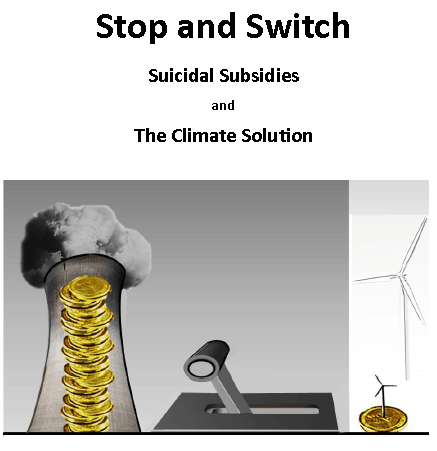
PDF
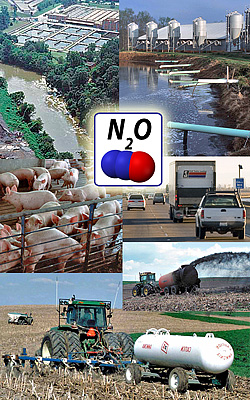
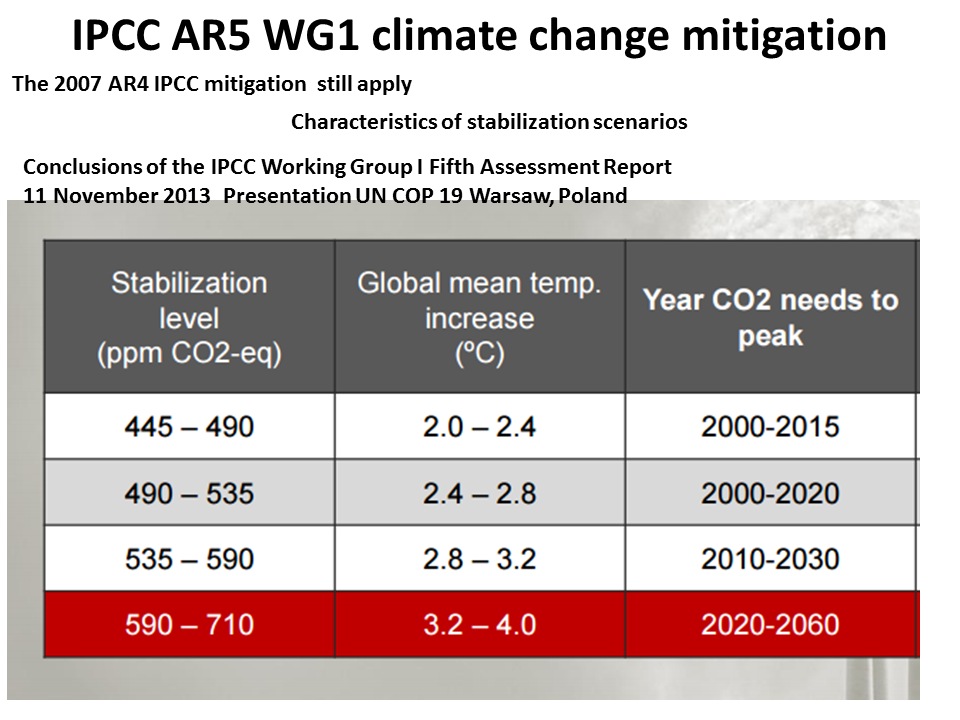
The best paper is Nature Climate Change 21 March 2016 Risk of multiple tipping points ... urgent global action on climate change ... immediate massive effort ... US$116/tCO2 ... carbon emissions stopped by 2050... < 1.5ºC CO2.
ATMOSPHERIC CO2 REMOVAL
Atmospheric CO2 has to brought to under 350 ppm for both climate and oceans. The only way to safely and surely reduce atmospheric CO2 is by direct mechanical air extraction and chemical conversion to solid carbonate (Nature: Sucking CO2 out of the air). There is a working prototype developed from University of Alberta research, but it needs lots of power to run the extraction equipment an a vast scale.
The most featured CO2 removal idea of burning biomass, capturing and storing the CO2 is not proven technology, and a bad idea that cannot work reliably at scale for long term, which is 200 years. There are several air extraction projects for development but inadequate funding.
To reduce ocean acidification requires a vast amount of atmospheric CO2 removal for hundreds of years.
ARCTIC AMPLIFYING FEEDBACK EMISSIONS
An additional catastrophe now in the making is that the warming planet is already releasing GHG feedback emissions. Thawing Arctic permafrost (which holds double atmospheric carbon) is releasing all 3 GHGs: methane, CO2 and nitrous oxide. A regional Arctic emergency cooling capacity must be developed to switch off feedback emissions if they are increasing atmospheric GHGs.
Only a massive global Manhattan-style project, integrated with heavily funded science and development, can provide all of these capacities to operate on a worldwide basis in a matter of years, not decades.
The CAN International 2014 response of global civil society calls for global emissions decline in a year, to reach zero by 2050 (at the very latest) by 100% replacement of all fossil energy by clean renewable energy. In other words, the end of the fossil fuel era.
All we have to know is that:
DEADLY MITIGATION ERRORS
Natural methane gas is no bridge to low or zero carbon. It is at least as bad as coal Global Mar 2016 Bill Mckibben Global Warming’s Terrifying New Chemistry.
New zero carbon renewables are low energy density that can only replace electricity- not fossil fuel high energy density for heavy or transportation. Our only high energy density Zero carbon nuclear fission energy is being ruled out for mitigation in Europe and the USA.
Earth Policy Institute Plan B4 Lester Brown 2009 - still the only comprehensive plan for climate
but in 2016 more is needed is needed to bring atmospheric CO2 down.
Vision of Earth best easy comprehensive energies source
We only have a few years to get the well known mitigation solutions on line.
The December 2015 UN Paris Climate Agreement was encouraging,acknowledging (again) the great urgency of dealing with disastrous climate and ocean change or rather disruptions, but there is no commitment to any emergency measures. Paris is a call to action but the agreement continues the delay in international action to implement the UN climate change convention. A legally binding commitment to real measures was blocked by fossil fuel pushing powers.
Center for International Environmental Law statement
A Powerful Signal but a Weak Agreement in Paris: Global Movement for Climate Action Must Accelerate
The oceans were only barely mentioned in the Paris Agreement and not considered in the negotiations.
Global emissions have to be put into a fixed fast decline, and it is still possible.
June 2015 Ecowatch (& ref to Climate Mobilization) America's zero carbon in years imperative response to the planetary emergency
Under 1.5C A response aimed for 2C is no response. 1.5C is on the UN agenda and is the position of majority of nation Parties to the climate convention
Ecofys Nov 2015 explains by the 1.5 to Stay Alive imperative now applies to all of us- all of our children and grand children 2015. A Nov 2015 paper by C.-F. Schleussner results reveal a substantial difference in impacts between 1.5C and 2.0C) and a 2015 paper by Petra Tschakert ('Without a doubt, it is in the utmost interest of a large number of countries to pursue the 1.5°C target, and to see it anchored as a binding goal in the next agreement') make it clear 1.5C is a must for future survival, not 2C.
THE CLIMATE SCIENCE BOTTOM LINE IS ZERO CARBON EMISSIONS
Climate Action Network International's 2014 Position statement is the best emergency response, which calls for an immediate peak to decline of emissions, under 1.5C by 2100. (CAN Int. is 900 organization in over 100 countries) and zero carbon with zero industrial fossil fuel energy by 2050. CAN calls for fuel costing of externalized fossil fuel pollution costs. From the current research we propose $32-103/tCO2 (2015) rising to $82-260/tCO2 by 2035, bearing mind that even the higher amount does not account for the full costs.
Canada's 2015 civil society LEAP Manifesto is similar.
PEAK EMISSIONS According to the AR5 2013 WG1 report presentation at COP 19 2013, the 2007 AR4
mitigation projections for peak emissions still applies, which is 2015)
19 Nov 2015 More research shows again the world can be run on 100% clean renewable energy.
IPCC 2014 AR5 assessment response.
The best case emissions scenario (RCP2.6) has emissions declining from 2020. It is the only scenario not above 2C (catastrophe) by 2100 and the only one that does not keep increasing after 2100. It declines to zero emissions by 2100. It is most important to note that AR5 only uses this is CO2 equivalent emissions for mitigation which inludes methane and nitrous oxide and all must be zeroed this century (see Synthesis Headline Statements on mitigation pathways).
29 June 2015 Call for an ambitious and credible climate agreement in Paris by economists
The 8 June 2015 G7 Declaration on climate fits as an ergency response and is in fact
the IPCC AR5 most stringent range of the AR5 best case emissions scenario RCP2.6.
G7 climate formula
Reduce greenhouse gas emissions 70% (on 2010) by 2050, on the way to
zero carbon emissions over the course of this century.
Terminate fossil fuel subsidies.
Besides the G7 there are two globally determined responses available, that both call for immediate actions with the goal of zero carbon emissions.
They are the Climate Action Network's 2014 Position Statement, and the
IPCC AR5 2014 best case emissions scenario called RCP2.6 (PDF),
(see both graph opposite) which all the scientists and all governments have acknowledged
and approved. The IPCC however does not publish or promote recommendations so we must.
Emissions must stop increasing right away.
They must decline from 2015 (or at 2015 today- within a year) by the CAN INt.
The IPCC RCP2.6 has emissions declining from 2020 at the latest
Zero carbon emissions is the priority target
Global warming limit under 1.5C
Atmospheric CO2 limit - under 350 ppm CO2 (now 400ppm)
Zero carbon emissions in 20 years & must be by 2050 and
Convert fossil fuels to 100% renewable energy as above
- no energy by combustion.
Subsidizing fossil fuels stops in one year for Annex 1 industrialized nations and for
Annex 2 developing nations phased out over 5 years. Large direct subsidies must be switched to rapid clean renewable energy development.
Tax deductible renewable energy investment by individual.
Carbon dioxide- GHG pollution fee for Annex 1 industrialized nations from $30/t.carbon from 2015 up to $200/t. rising annually by 10/t and Annex 2 developing nations $10/t.carbon from 2025.
Nuclear energy - update & increase world nuclear capacity. It is far too late now to reduild the world for renewable energy without using nuclear powerr (instead of coal) to do so.
Zero deforestation by 2020 Soils for Food SDecuirty and Climate
Convert food production to organic(agro-forestry, permaculture) with -ve emissions
e.g. the 2015 France 40% Initiative Soils for Food Security and Climate
Climate change monitoring capacities immediate massive upgrade.
No planetary scale geo-engineering
ATMOSPHERIC CO2 REMOVAL
Atmospheric CO2 has to brought to under 350 ppm for both climate and oceans. The only way to safely and surely reduce atmospheric CO2 is by direct mechanical air extraction and chemical conversion to solid carbonate (Nature: Sucking CO2 out of the air). There is a working prototype developed from University of Alberta research, but it needs lots of power to run the extraction equipment an a vast scale.
The most featured CO2 removal idea of burning biomass, capturing and storing the CO2 is not proven technology, and a bad idea that cannot work reliably at scale for long term, which is 200 years. There are several air extraction projects for development but inadequate funding.
To reduce ocean acidification requires a vast amount of atmospheric CO2 removal for hundreds of years.
ARCTIC AMPLIFYING FEEDBACK EMISSIONS
An additional catastrophe now in the making is that the warming planet is already releasing GHG feedback emissions. Thawing Arctic permafrost (which holds double atmospheric carbon) is releasing all 3 GHGs: methane, CO2 and nitrous oxide. A regional Arctic emergency cooling capacity must be developed to switch off feedback emissions if they are increasing atmospheric GHGs.
Only a massive global Manhattan-style project, integrated with heavily funded science and development, can provide all of these capacities to operate on a worldwide basis in a matter of years, not decades.
The CAN International 2014 response of global civil society calls for global emissions decline in a year, to reach zero by 2050 (at the very latest) by 100% replacement of all fossil energy by clean renewable energy. In other words, the end of the fossil fuel era.
All we have to know is that:
- 2016 Global temperature and atmospheric CO2 are at record highs and record one-year increase (StateOfOurClimate.com)
- Emissions of CO2, methane and nitrous have to be "nearly zero" (IPCC AR5) to stop the temperature (and ocean acidification) from increasing.
- Continued increase in the atmospheric GHGs will at some point render Earth uninhabitable.
- The faster emissions are peaked (to decline), the lower is the possible atmospheric stabilization levels.
- The quicker we get to zero, the higher is our chance of survival.
DEADLY MITIGATION ERRORS
Natural methane gas is no bridge to low or zero carbon. It is at least as bad as coal Global Mar 2016 Bill Mckibben Global Warming’s Terrifying New Chemistry.
New zero carbon renewables are low energy density that can only replace electricity- not fossil fuel high energy density for heavy or transportation. Our only high energy density Zero carbon nuclear fission energy is being ruled out for mitigation in Europe and the USA.
Earth Policy Institute Plan B4 Lester Brown 2009 - still the only comprehensive plan for climate
but in 2016 more is needed is needed to bring atmospheric CO2 down.
Vision of Earth best easy comprehensive energies source
We only have a few years to get the well known mitigation solutions on line.
The December 2015 UN Paris Climate Agreement was encouraging,acknowledging (again) the great urgency of dealing with disastrous climate and ocean change or rather disruptions, but there is no commitment to any emergency measures. Paris is a call to action but the agreement continues the delay in international action to implement the UN climate change convention. A legally binding commitment to real measures was blocked by fossil fuel pushing powers.
Center for International Environmental Law statement
A Powerful Signal but a Weak Agreement in Paris: Global Movement for Climate Action Must Accelerate
The oceans were only barely mentioned in the Paris Agreement and not considered in the negotiations.
Global emissions have to be put into a fixed fast decline, and it is still possible.
June 2015 Ecowatch (& ref to Climate Mobilization) America's zero carbon in years imperative response to the planetary emergency
Under 1.5C A response aimed for 2C is no response. 1.5C is on the UN agenda and is the position of majority of nation Parties to the climate convention
Ecofys Nov 2015 explains by the 1.5 to Stay Alive imperative now applies to all of us- all of our children and grand children 2015. A Nov 2015 paper by C.-F. Schleussner results reveal a substantial difference in impacts between 1.5C and 2.0C) and a 2015 paper by Petra Tschakert ('Without a doubt, it is in the utmost interest of a large number of countries to pursue the 1.5°C target, and to see it anchored as a binding goal in the next agreement') make it clear 1.5C is a must for future survival, not 2C.
THE CLIMATE SCIENCE BOTTOM LINE IS ZERO CARBON EMISSIONS
Climate Action Network International's 2014 Position statement is the best emergency response, which calls for an immediate peak to decline of emissions, under 1.5C by 2100. (CAN Int. is 900 organization in over 100 countries) and zero carbon with zero industrial fossil fuel energy by 2050. CAN calls for fuel costing of externalized fossil fuel pollution costs. From the current research we propose $32-103/tCO2 (2015) rising to $82-260/tCO2 by 2035, bearing mind that even the higher amount does not account for the full costs.
Canada's 2015 civil society LEAP Manifesto is similar.
PEAK EMISSIONS According to the AR5 2013 WG1 report presentation at COP 19 2013, the 2007 AR4
mitigation projections for peak emissions still applies, which is 2015)
19 Nov 2015 More research shows again the world can be run on 100% clean renewable energy.
IPCC 2014 AR5 assessment response.
The best case emissions scenario (RCP2.6) has emissions declining from 2020. It is the only scenario not above 2C (catastrophe) by 2100 and the only one that does not keep increasing after 2100. It declines to zero emissions by 2100. It is most important to note that AR5 only uses this is CO2 equivalent emissions for mitigation which inludes methane and nitrous oxide and all must be zeroed this century (see Synthesis Headline Statements on mitigation pathways).
29 June 2015 Call for an ambitious and credible climate agreement in Paris by economists
The 8 June 2015 G7 Declaration on climate fits as an ergency response and is in fact
the IPCC AR5 most stringent range of the AR5 best case emissions scenario RCP2.6.
G7 climate formula
Reduce greenhouse gas emissions 70% (on 2010) by 2050, on the way to
zero carbon emissions over the course of this century.
Terminate fossil fuel subsidies.
Besides the G7 there are two globally determined responses available, that both call for immediate actions with the goal of zero carbon emissions.
They are the Climate Action Network's 2014 Position Statement, and the
IPCC AR5 2014 best case emissions scenario called RCP2.6 (PDF),
(see both graph opposite) which all the scientists and all governments have acknowledged
and approved. The IPCC however does not publish or promote recommendations so we must.
Emissions must stop increasing right away.
They must decline from 2015 (or at 2015 today- within a year) by the CAN INt.
The IPCC RCP2.6 has emissions declining from 2020 at the latest
Zero carbon emissions is the priority target
Global warming limit under 1.5C
Atmospheric CO2 limit - under 350 ppm CO2 (now 400ppm)
Zero carbon emissions in 20 years & must be by 2050 and
Convert fossil fuels to 100% renewable energy as above
- no energy by combustion.
Subsidizing fossil fuels stops in one year for Annex 1 industrialized nations and for
Annex 2 developing nations phased out over 5 years. Large direct subsidies must be switched to rapid clean renewable energy development.
Tax deductible renewable energy investment by individual.
Carbon dioxide- GHG pollution fee for Annex 1 industrialized nations from $30/t.carbon from 2015 up to $200/t. rising annually by 10/t and Annex 2 developing nations $10/t.carbon from 2025.
Nuclear energy - update & increase world nuclear capacity. It is far too late now to reduild the world for renewable energy without using nuclear powerr (instead of coal) to do so.
Zero deforestation by 2020 Soils for Food SDecuirty and Climate
Convert food production to organic(agro-forestry, permaculture) with -ve emissions
e.g. the 2015 France 40% Initiative Soils for Food Security and Climate
Climate change monitoring capacities immediate massive upgrade.
No planetary scale geo-engineering
Remember the response plan must be dictated by the science of the 2014 IPCC 5th assessment (AR5) but none is. That is 'near zero' emissions for CO2- and methane and nitrous oxide.
Conversionis the key word for getting to 'near zero' GHG emissions (IPCC AR5). Doing better, and lower carbon, is good but in this case not good enough. We have to do things differently.
Personal living. It is a given that all in the Global North must convert their wasteful consumer culture to conserver culture. That can never get us anywhere near zero carbon, and in fact allows more fossil fuel globalization. It is still essential because the more energy we conserve the faster we can make the fossil fuel zero conversion.
For zero carbon it follows that ALL fossil fuel energy must be replaced by 100% virtual zero carbon clean energy (as in the 2014 Climate Action Network Int Position Statement.
This reduces much more more than CO2 emissions, because fossil fuel combustion also emits methane (a lot now from natural gas), some
nitrous oxide, black carbon (2nd only to CO2 in warming), and is
responsible for ground level ozone (a GHG).
Energy/power DENSITY Fossil fuel conversion can be done for domestic electricity, but not yet for heavy manufacturing and heavy transport, which requires very high energy dense power (presently mostly fossil fuels, with some big dam hydro and some nuclear fission). Wind turbines today are being made by burning coal. This is not being taken into account. The exception is concentrated solar thermal with molten salt heat storage, which is high energy but much less than fission.
Getting to zero carbon fast can only be done using very high energy dense compact reactor nuclear fission power on the way to super high energy dense compact fusion power, in order to manufacture the vast amount of clean renewable infrastructure to rebuild the world for zero carbon. Ships
The two articles below are excellent on information but are low carbon- not zero carbon solutions. Change the (reduced) fossil fuel and biomass components makes for a good zero carbon plan.
https://www.lowtechmagazine.com/2011/07/solar-powered-factories.html
https://www.lowtechmagazine.com/2015/04/how-sustainable-is-pv-solar-power.html
It has not been recognized that methane and nitrous oxide must be zeroed, as well as CO2. The essential conversions for methane and nitrous oxide mitigation as welkl as CO2 are shown by the above illustrations.
The only AR5 emissions sceanario not above the catastrophic 2ºC by 2100 (>66% chance) and the only one not leading to increasing temperatures above 2ºC after 2100, is the best-case scenario, RCP2.6. This also the only one that could stabilze temperature increase limit to 1.5C.
For this scenario, emissions of CO2 equivalent (CO2, methane, nitrous oxide & halocarbons) peak on an immediate-term basis from 2015 and decline fast from 2020.
Carbon farming (VIDEO)is essential and potentially powerful for long term mitigation of CO2, as well as methane and nitrous oxide. (See image above.) Research Nov 2019 Carbon sinking open to question
Ocean farming to counter ocean acidification is a theoretical possibility
Fast black carbon (BC) mitigation is vital. (See image above.) A fast- acting, easily feasible measure that would largely correct today's disastrous global warming is black carbon soot mitigation, because BC is second only to CO2 as a warming emission.
CO2 direct air extraction However, even accomplishing the above will not stabilize global climate disruption or ocean acidification at levels to avoid planetary catastrophe because atmospheric CO2 is now so extremley high (above 400 ppm). It has to drop to below 350 ppm, which is only possible with extraction of CO2 from the air. But, the only ways to reliably and safely extract CO2 is by direct mechanical and/or chemical technologies, which exsit but are not being promoted.
Conversionis the key word for getting to 'near zero' GHG emissions (IPCC AR5). Doing better, and lower carbon, is good but in this case not good enough. We have to do things differently.
Personal living. It is a given that all in the Global North must convert their wasteful consumer culture to conserver culture. That can never get us anywhere near zero carbon, and in fact allows more fossil fuel globalization. It is still essential because the more energy we conserve the faster we can make the fossil fuel zero conversion.
For zero carbon it follows that ALL fossil fuel energy must be replaced by 100% virtual zero carbon clean energy (as in the 2014 Climate Action Network Int Position Statement.
This reduces much more more than CO2 emissions, because fossil fuel combustion also emits methane (a lot now from natural gas), some
nitrous oxide, black carbon (2nd only to CO2 in warming), and is
responsible for ground level ozone (a GHG).
Energy/power DENSITY Fossil fuel conversion can be done for domestic electricity, but not yet for heavy manufacturing and heavy transport, which requires very high energy dense power (presently mostly fossil fuels, with some big dam hydro and some nuclear fission). Wind turbines today are being made by burning coal. This is not being taken into account. The exception is concentrated solar thermal with molten salt heat storage, which is high energy but much less than fission.
Getting to zero carbon fast can only be done using very high energy dense compact reactor nuclear fission power on the way to super high energy dense compact fusion power, in order to manufacture the vast amount of clean renewable infrastructure to rebuild the world for zero carbon. Ships
The two articles below are excellent on information but are low carbon- not zero carbon solutions. Change the (reduced) fossil fuel and biomass components makes for a good zero carbon plan.
https://www.lowtechmagazine.com/2011/07/solar-powered-factories.html
https://www.lowtechmagazine.com/2015/04/how-sustainable-is-pv-solar-power.html
It has not been recognized that methane and nitrous oxide must be zeroed, as well as CO2. The essential conversions for methane and nitrous oxide mitigation as welkl as CO2 are shown by the above illustrations.
The only AR5 emissions sceanario not above the catastrophic 2ºC by 2100 (>66% chance) and the only one not leading to increasing temperatures above 2ºC after 2100, is the best-case scenario, RCP2.6. This also the only one that could stabilze temperature increase limit to 1.5C.
For this scenario, emissions of CO2 equivalent (CO2, methane, nitrous oxide & halocarbons) peak on an immediate-term basis from 2015 and decline fast from 2020.
Carbon farming (VIDEO)is essential and potentially powerful for long term mitigation of CO2, as well as methane and nitrous oxide. (See image above.) Research Nov 2019 Carbon sinking open to question
Ocean farming to counter ocean acidification is a theoretical possibility
Fast black carbon (BC) mitigation is vital. (See image above.) A fast- acting, easily feasible measure that would largely correct today's disastrous global warming is black carbon soot mitigation, because BC is second only to CO2 as a warming emission.
CO2 direct air extraction However, even accomplishing the above will not stabilize global climate disruption or ocean acidification at levels to avoid planetary catastrophe because atmospheric CO2 is now so extremley high (above 400 ppm). It has to drop to below 350 ppm, which is only possible with extraction of CO2 from the air. But, the only ways to reliably and safely extract CO2 is by direct mechanical and/or chemical technologies, which exsit but are not being promoted.
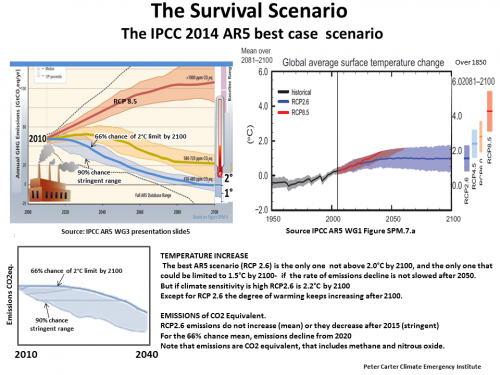
ENERGY RESPONSE
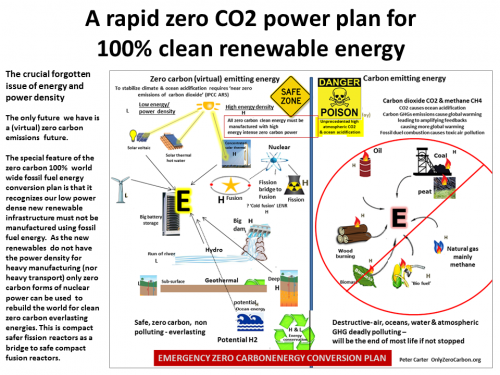
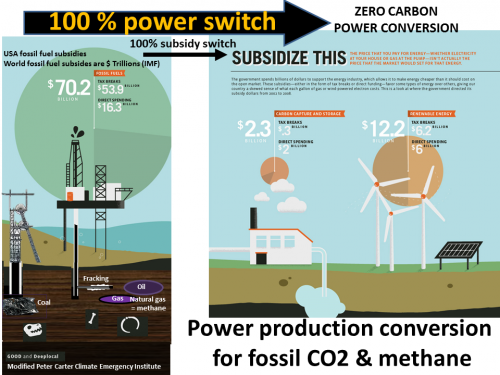


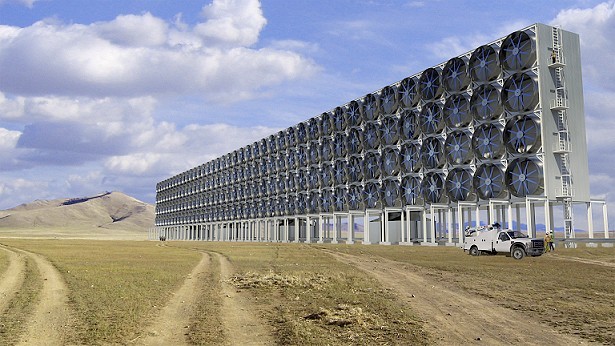
IPCC 2018 1.5C report confirms that 2018 THE ONLY CLIMATE CHANGE RESPONSE IS AN IMMEDIATE EMERGENCY RESPONSE. Global fossil CO2 declines from 2020. Otherwise the Report says CO2 removal is necessary, though this is not feasible and using bio-energy carbon capture & storage (BECCS) is a horrid idea that just adds more damage.
The zero combustion world energy economy is the safest, clearest,surest and most feasible carbon conversion / decarbonization
Energy austerity and veganism
Atmospheric CO2 is now so high (408 ppm) that avoiding global land and oceans collapse can only result from a huge decrease is energy consumption, which means energy and manufactured goods austerity. As it is phased down fossil fuel energy must be dedicated to renewable energy manufacturing. Atmospheric methane is so high that global veganisation is essential. The world population increase is now contributing to increased emissions, so population must be zeroed and then declined to one child families.
Black carbon & methane. (IPCC 1.5C Report confirms) With global warming now 1.1C, and predicted (UN Met Office) to increase to 2022, a strategy for survival requires rapid reduction in the rapidly responding global warming of black carbon (BC) soot (2nd only to CO2 for warming) and methane. Cutting BC would act immediately and cutting methane would act in a few years as methane lasts a decade. In contrast CO2 emissions last 100-20 years (CDIAC rough average). This is in addition to immediate rapid global decline in CO2 emissions. Cutting methane means cutting out meat.
All sources (2017) on climate change mitigation agree than global emissions must decline on
an immediate basis to keep under 1.5C or 2C by 2100, which would be much higher long by equilibrium after 2100. 2C equilibrium is global suicide as it would trigger planet feedback carbon catastrophe runaway, and world agricultural output decline and ocean catastrophe. The consensus now (since UN Paris Agreement) is a long term aim for under 1.5C.
Near zero CO2e (CO2, Methane & nitrous oxide) emissions is mandated by the IPCC , which is the best case IPCC 2014 AR5 emissions scenario, RCP2.6, and which requires global CO2e emissions to decline rapidly from 2020 (latest). CO2e includes methane and nitrous oxide with CO2 and is used exclusively by the IPCC for mitigation calculations. Peaking simply means the year global emissions go into decline.
Immediate termination of fossil fuel & other GHG emissions driving subsidies is obviously fundamental and is universally recommended.
The 2011 IPCC Special Report on Renewable Energy Sources and Climate Change Mitigation noted that 'The global technical potential of RE sources will not limit continued growth in the use of RE. ...studies have consistently found that the total global technical potential for RE is substantially higher than global energy demand. The technical potential for solar energy is the highest among the RE sources, but substantial technical potential exists for all six RE sources'.
The zero combustion world energy economy is the safest, clearest,surest and most feasible carbon conversion / decarbonization
Energy austerity and veganism
Atmospheric CO2 is now so high (408 ppm) that avoiding global land and oceans collapse can only result from a huge decrease is energy consumption, which means energy and manufactured goods austerity. As it is phased down fossil fuel energy must be dedicated to renewable energy manufacturing. Atmospheric methane is so high that global veganisation is essential. The world population increase is now contributing to increased emissions, so population must be zeroed and then declined to one child families.
Black carbon & methane. (IPCC 1.5C Report confirms) With global warming now 1.1C, and predicted (UN Met Office) to increase to 2022, a strategy for survival requires rapid reduction in the rapidly responding global warming of black carbon (BC) soot (2nd only to CO2 for warming) and methane. Cutting BC would act immediately and cutting methane would act in a few years as methane lasts a decade. In contrast CO2 emissions last 100-20 years (CDIAC rough average). This is in addition to immediate rapid global decline in CO2 emissions. Cutting methane means cutting out meat.
All sources (2017) on climate change mitigation agree than global emissions must decline on
an immediate basis to keep under 1.5C or 2C by 2100, which would be much higher long by equilibrium after 2100. 2C equilibrium is global suicide as it would trigger planet feedback carbon catastrophe runaway, and world agricultural output decline and ocean catastrophe. The consensus now (since UN Paris Agreement) is a long term aim for under 1.5C.
Near zero CO2e (CO2, Methane & nitrous oxide) emissions is mandated by the IPCC , which is the best case IPCC 2014 AR5 emissions scenario, RCP2.6, and which requires global CO2e emissions to decline rapidly from 2020 (latest). CO2e includes methane and nitrous oxide with CO2 and is used exclusively by the IPCC for mitigation calculations. Peaking simply means the year global emissions go into decline.
Immediate termination of fossil fuel & other GHG emissions driving subsidies is obviously fundamental and is universally recommended.
The 2011 IPCC Special Report on Renewable Energy Sources and Climate Change Mitigation noted that 'The global technical potential of RE sources will not limit continued growth in the use of RE. ...studies have consistently found that the total global technical potential for RE is substantially higher than global energy demand. The technical potential for solar energy is the highest among the RE sources, but substantial technical potential exists for all six RE sources'.
26 Oct 2019 by Morgan Stanley report , found that to reduce net carbon emissions to zero and meet the Paris Agreement’s goal, the world would have to eliminate 53.5 billion metric tons of carbon dioxide each year for the catastrophic 2C, requiring $50Trillon by 2050
CO2 removal (CDR) We are opposed in principle to geoengineering for planet cooling and for CO2 removal except direct air capture. Latest research was published by Environmental Research Letters 2018 Special issue Focus on Negative Emissions, According to the IPCC 2014 AR5 global emissions reduction has been delayed for so long that '-ve emissions' or CO2 removal is now required. The 2018 IPCC 1.5C report's best case P1 scenario has no CCS nor CO2 removal, but the report assumes CO2 removal is feasible- it is not. It would be opposed by CO2 out-gassing from the oceans for many years. Non geoengineering safe effective CDR includes regenerative agriculture, biochar, afforestation and wood construction in place of steel & concrete. CDR geo-engineering methods are not mature technologies and all sources conclude their practical value at scale to be questionable. The most published CDR method is bioenergy + carbon capture sequestration (BECCS). There are potential direct air capture technologies (DAC) but the IPCC treats these as too expensive. Many IPCC reports address CDR. The IPCC 2007 AR4 WG3 included CDR in equilibrium warming of 2C. 2011 IPCC Expert Meeting on Geoengineering. IPCC 2014 AR5b WG 3 SPM says: The availability and scale of Carbon Dioxide Removal (CDR) technologies and methods are uncertain and CDR technologies and methods are, associated with challenges and risks (high confidence). Springer in 2013 published a special issue on -ve emissions. The most comprehensive IPCC 2014 AR5 BECCS assessment is WG3 11.13 Appendix Bioenergy.Recent 2017 review shows that even after many years of consideration CDR has made no real progress. The most recent report,(Feb 2018) is on the UN Climate Sec site by the European Academies Science Advisory Council, which does not support BECCS and concludes 'these technologies offer only limited realistic potential to remove carbon from the atmosphere' .. 'and not at the levels required to compensate for inadequate mitigation'. The really bad news is research finding that CDR is of little to no help for the ocean disruption. CDR theoretical potentials have been published nevertheless. All methods need to to be tried as part of the planetary emergency response but assumed effectiveness should not be relied for mitigation policy. Despite being included in many models and mitigation papers, it therefore remains unknown if CCS, BECCS or DAC are feasible and we have to assume will not stop ocean heating, acidification and deoxygenation. As the oceans are the ultimate determinant of climate this makes the Earth emergency doubly dire. We need a planet emergency global massive Manhattan model project.
Pricing carbon (MIT 2007) is a must and must be applied by governments charging a full pollution cost carbon fee so-called tax. A regulated cap-emissions limit and carbon trade may be added but in practice may have little effect. Such market failure correction is obviously beneficial for renewable energy, but also may determine if carbon capture storage (CCS) or even CO2 removal are feasible.
Global climate system disruption (land-oceans-forests-Arctic ) and and global ecosystem disruption
Global surface temperature and atmospheric CO2 for 2015 and for 2016 were big record highs and record annual increases.
Atmospheric CO2 is accelerating to the end of 2016 even though there was no increase in CO2 emissions for 2014 and 2015. Ocean acidification and heat content are accelerating.
Obviously there is no allowable carbon budget to burn more fossil fuels in this most perilous situation. Clearly the whole world is on a fast fixed heading for global suicide.
The future is the solar age- or no future, if the fossil fuel industry is allowed to keep the world dependent on and dominated by fossil fuels.
This as been known for decades (The Politics of the Solar Age 1975-2015 Hazel Henderson). The latest science makes this certain 'We Could Power The Entire World By Harnessing Solar Energy From 1% Of The Sahara' (Forbes 22 Sep 2016)- Prof Mehran Moalem, PhD, UC Berkeley.
ALL fossil fuel energy must be replaced by clean virtual zero carbon ever lasting energy. That is because of the definite science of zero carbon emissions, without which global temperature and ocean acidification cannot stabilize (onlyzerocarbon.org).
Renewable energy can repower the world according to the IPCC in its 2011 renewable energy report that all fossil fuel energy could be replaced by renewable energies, for an investment of 1% of global GDP or $5 over the next decade. This is the same as governments have been giving to the fossil fuel industries in subsidies (IMF 2015).
Obviously all fossil fuel subsidies must stop in short order and the full costs of pollution must be charged to central GHG source polluters.
This plan aims to provide the comprehensive science based mitigation response to accelerating climate system (and oceans) disruption.
Greenhouse gas pollution today is a definite planetary emergency for climate, food, forests, the Arctic, ice sheets and oceans, calling for emergency mitigation. This applies to billions of people today and all future generations.
The first response is to declare the planetary emergency.
An emergency response requires a climate mobilization by governments and public (Plan B4 Lester Brown, The Climate Mobilization)
The only feasible global mitigation emissions response for the climate and oceans is the IPCC AR5 best case emissions scenario, called RCP 2.6)- which is an immediate basis global emissions decline.
Best behavioural or life style practices for carbon footprint reductionis a given, well known for many years so not described here, except to say that for methane the meat based diet must be converted.
It is necessary to first emphasize what measures are no part of an emergency response plan, as they are unproven, dangerous, provide an excuse to keep emitting and unnecessary (if emergency emissions cuts are taken):
The Burning Age is over and the only solution to carbon pollution is conversion to a (virtual) zero carbon clean renewable energy economy.
Zero carbon means zero deforestation, plus global afforestation
But RCP 2.6 means more than zero carbon is required. Methane and nitrous oxide emissions must be zeroed too.
There is no zero carbon plan or road-map. The only plans for energy and climate is to increase global emissions for decades.
The UN Paris Agreement is just the opposite- MORE emissions. The May 2016 UN Climate Change Secretariat Update of intended national emissions targets (INDCs) shows that after Paris emissions will still be higher at 2030, and proves that nothing is going to be done to save our future without a global emergency mass climate mobilization.
Our planet is on the brink of runaway climate change - total planetary catastrophe.
We have to convert our industrial GHG polluting world to a non GHG polluting one and fast. An immediate International Planetary Emergency Manhattan Marshall Model Venture(NOT planetary cooling) is now the only survival response — primarily for a big upgrade of our new clean energy technologies and to get safe, zero-combustion, super high energy density safe new fission and hopefully fusion power on line, which is now looking feasible. And we need safe direct air CO2 removal to get near zero CO2 emissions (not by burning biomass). For energy/power density, see Vaclav Smil and IPCC renewable energy report, SREEN.
IPCC 2014 AR5 science dictates the mitigation. There must be "substantial emissions reductions over the next few decades" and all long-lived (in the atmosphere) GHG emissions must be "near zero" for stabilization of now severely disrupted climate and also oceans.
CO2 removal (CDR) We are opposed in principle to geoengineering for planet cooling and for CO2 removal except direct air capture. Latest research was published by Environmental Research Letters 2018 Special issue Focus on Negative Emissions, According to the IPCC 2014 AR5 global emissions reduction has been delayed for so long that '-ve emissions' or CO2 removal is now required. The 2018 IPCC 1.5C report's best case P1 scenario has no CCS nor CO2 removal, but the report assumes CO2 removal is feasible- it is not. It would be opposed by CO2 out-gassing from the oceans for many years. Non geoengineering safe effective CDR includes regenerative agriculture, biochar, afforestation and wood construction in place of steel & concrete. CDR geo-engineering methods are not mature technologies and all sources conclude their practical value at scale to be questionable. The most published CDR method is bioenergy + carbon capture sequestration (BECCS). There are potential direct air capture technologies (DAC) but the IPCC treats these as too expensive. Many IPCC reports address CDR. The IPCC 2007 AR4 WG3 included CDR in equilibrium warming of 2C. 2011 IPCC Expert Meeting on Geoengineering. IPCC 2014 AR5b WG 3 SPM says: The availability and scale of Carbon Dioxide Removal (CDR) technologies and methods are uncertain and CDR technologies and methods are, associated with challenges and risks (high confidence). Springer in 2013 published a special issue on -ve emissions. The most comprehensive IPCC 2014 AR5 BECCS assessment is WG3 11.13 Appendix Bioenergy.Recent 2017 review shows that even after many years of consideration CDR has made no real progress. The most recent report,(Feb 2018) is on the UN Climate Sec site by the European Academies Science Advisory Council, which does not support BECCS and concludes 'these technologies offer only limited realistic potential to remove carbon from the atmosphere' .. 'and not at the levels required to compensate for inadequate mitigation'. The really bad news is research finding that CDR is of little to no help for the ocean disruption. CDR theoretical potentials have been published nevertheless. All methods need to to be tried as part of the planetary emergency response but assumed effectiveness should not be relied for mitigation policy. Despite being included in many models and mitigation papers, it therefore remains unknown if CCS, BECCS or DAC are feasible and we have to assume will not stop ocean heating, acidification and deoxygenation. As the oceans are the ultimate determinant of climate this makes the Earth emergency doubly dire. We need a planet emergency global massive Manhattan model project.
Pricing carbon (MIT 2007) is a must and must be applied by governments charging a full pollution cost carbon fee so-called tax. A regulated cap-emissions limit and carbon trade may be added but in practice may have little effect. Such market failure correction is obviously beneficial for renewable energy, but also may determine if carbon capture storage (CCS) or even CO2 removal are feasible.
Global climate system disruption (land-oceans-forests-Arctic ) and and global ecosystem disruption
(land-forests- oceans) with the 6th mass extinction are now so interlinked they have to be addressed as one- biological annihilation Earth emergency.
Mitigation and adaptation to climate disruption cannot be separated.
Atmospheric GHG pollution has reached such unprecedeted levels that we all will be impacted and so have to adapt- and that means we all have to mitigate. For individuals and groups adaptation to climate change includes personal mitigation and political pressure for mitigation.
Climate change litigation is growing globally and a sucessful response so far
See Our Childrens Trust
The bottom line for our common future survival is that global emissions must be declining now. This global emissions decline by 2020 is shown by all mitigation reports, but it is for only a 66% chance of a 2C warming only by 2100. This 2020 global emissions decline is the only 2C mitigation emissions scenario of the 2014 IPCC assessment (RCP2.6).
It now certain that for a 1.5C limit and a 2C long term equilibrium limit CO2 must be removed from the atmosphere (-ve emissions). How ever as in all mitigation sources this makes no difference to immediate rapid emissions decline. The world has no capacity for -ve emissions at present and future capacity will be very limited at best, see Feb 2018 EASC European Academies’ Science Advisory Council.
Avoiding dangerous impacts has always depended on So-called early peaking of global emisions. Delaying is globally deadly. 'The impacts avoided by 2100 are more strongly influenced by the date and level at which emissions peak than the rate of decline of emissions, with an earlier and lower emissions peak avoiding more impacts' (A global assessment of the effects of climate policy on the impacts of climate change, N. Arnell 2013).
The bottom line for our future common survival is immediate global decline in emissions to achieve 'substantial emissions reductions over the next few decades and near zero emissions of carbon dioxide and other long-lived greenhouse gases [i.e. CO2, methane and nitrous oxide] by the end of the century' (IPCC AR5 Synthesis Headlines).
'Long-lived greenhouse gases (LLGHGs), for example, CO2, methane (CH4) and nitrous oxide (N2O), are chemically stable and persist in the atmosphere over time scales of a decade to centuries or longer, so that their emission has a long-term influence on climate' (IPCC 2007 AR4)
2017 Experts say we must act NOW to slash global emissions - or we lose everything.
Nov 2017 Energy Watch 100% renewable electricity world is feasible, and cheaper
March 2017 A Carbon Law to Protect the Climate
March 2017 'Immediate global action to curb future warming is essential to secure a future for coral reefs'. Global warming and recurrent mass bleaching of corals
March 2016 'Immediate, massive effort to control CO2 emissions', which are stopped by mid-century, Risk of multiple interacting tipping points should encourage rapid CO2 emission reduction
The Solutions Project based on the Mark Jacobson Stanford team work. By far the best plan for energy decarbonization, using 100% clean and renewable wind, water, and solar energy to repower the world
Mitigation and adaptation to climate disruption cannot be separated.
Atmospheric GHG pollution has reached such unprecedeted levels that we all will be impacted and so have to adapt- and that means we all have to mitigate. For individuals and groups adaptation to climate change includes personal mitigation and political pressure for mitigation.
Climate change litigation is growing globally and a sucessful response so far
See Our Childrens Trust
The bottom line for our common future survival is that global emissions must be declining now. This global emissions decline by 2020 is shown by all mitigation reports, but it is for only a 66% chance of a 2C warming only by 2100. This 2020 global emissions decline is the only 2C mitigation emissions scenario of the 2014 IPCC assessment (RCP2.6).
It now certain that for a 1.5C limit and a 2C long term equilibrium limit CO2 must be removed from the atmosphere (-ve emissions). How ever as in all mitigation sources this makes no difference to immediate rapid emissions decline. The world has no capacity for -ve emissions at present and future capacity will be very limited at best, see Feb 2018 EASC European Academies’ Science Advisory Council.
Avoiding dangerous impacts has always depended on So-called early peaking of global emisions. Delaying is globally deadly. 'The impacts avoided by 2100 are more strongly influenced by the date and level at which emissions peak than the rate of decline of emissions, with an earlier and lower emissions peak avoiding more impacts' (A global assessment of the effects of climate policy on the impacts of climate change, N. Arnell 2013).
The bottom line for our future common survival is immediate global decline in emissions to achieve 'substantial emissions reductions over the next few decades and near zero emissions of carbon dioxide and other long-lived greenhouse gases [i.e. CO2, methane and nitrous oxide] by the end of the century' (IPCC AR5 Synthesis Headlines).
'Long-lived greenhouse gases (LLGHGs), for example, CO2, methane (CH4) and nitrous oxide (N2O), are chemically stable and persist in the atmosphere over time scales of a decade to centuries or longer, so that their emission has a long-term influence on climate' (IPCC 2007 AR4)
2017 Experts say we must act NOW to slash global emissions - or we lose everything.
Nov 2017 Energy Watch 100% renewable electricity world is feasible, and cheaper
March 2017 A Carbon Law to Protect the Climate
March 2017 'Immediate global action to curb future warming is essential to secure a future for coral reefs'. Global warming and recurrent mass bleaching of corals
March 2016 'Immediate, massive effort to control CO2 emissions', which are stopped by mid-century, Risk of multiple interacting tipping points should encourage rapid CO2 emission reduction
The Solutions Project based on the Mark Jacobson Stanford team work. By far the best plan for energy decarbonization, using 100% clean and renewable wind, water, and solar energy to repower the world
(Sept 2017 139 countries).
Mission Impossible-Possible
Massive Manhattan-Apollo- Marshall project. The more today's unprecedented atmospheric GHG pollution is studied the more impossible it seems to now prevent planetary catastrophe. It is now become a 'mission impossible' situation that requires nothing less than an immediate planetary emergency massive international Manhattan-Marshall type venture to rebuild our world. Dec 2016 Prof. Hans Joachim Schellnhuber.
Mission Impossible-Possible
Massive Manhattan-Apollo- Marshall project. The more today's unprecedented atmospheric GHG pollution is studied the more impossible it seems to now prevent planetary catastrophe. It is now become a 'mission impossible' situation that requires nothing less than an immediate planetary emergency massive international Manhattan-Marshall type venture to rebuild our world. Dec 2016 Prof. Hans Joachim Schellnhuber.
Global surface temperature and atmospheric CO2 for 2015 and for 2016 were big record highs and record annual increases.
Atmospheric CO2 is accelerating to the end of 2016 even though there was no increase in CO2 emissions for 2014 and 2015. Ocean acidification and heat content are accelerating.
Obviously there is no allowable carbon budget to burn more fossil fuels in this most perilous situation. Clearly the whole world is on a fast fixed heading for global suicide.
The future is the solar age- or no future, if the fossil fuel industry is allowed to keep the world dependent on and dominated by fossil fuels.
This as been known for decades (The Politics of the Solar Age 1975-2015 Hazel Henderson). The latest science makes this certain 'We Could Power The Entire World By Harnessing Solar Energy From 1% Of The Sahara' (Forbes 22 Sep 2016)- Prof Mehran Moalem, PhD, UC Berkeley.
ALL fossil fuel energy must be replaced by clean virtual zero carbon ever lasting energy. That is because of the definite science of zero carbon emissions, without which global temperature and ocean acidification cannot stabilize (onlyzerocarbon.org).
Renewable energy can repower the world according to the IPCC in its 2011 renewable energy report that all fossil fuel energy could be replaced by renewable energies, for an investment of 1% of global GDP or $5 over the next decade. This is the same as governments have been giving to the fossil fuel industries in subsidies (IMF 2015).
Obviously all fossil fuel subsidies must stop in short order and the full costs of pollution must be charged to central GHG source polluters.
This plan aims to provide the comprehensive science based mitigation response to accelerating climate system (and oceans) disruption.
Greenhouse gas pollution today is a definite planetary emergency for climate, food, forests, the Arctic, ice sheets and oceans, calling for emergency mitigation. This applies to billions of people today and all future generations.
The first response is to declare the planetary emergency.
An emergency response requires a climate mobilization by governments and public (Plan B4 Lester Brown, The Climate Mobilization)
The only feasible global mitigation emissions response for the climate and oceans is the IPCC AR5 best case emissions scenario, called RCP 2.6)- which is an immediate basis global emissions decline.
Best behavioural or life style practices for carbon footprint reductionis a given, well known for many years so not described here, except to say that for methane the meat based diet must be converted.
It is necessary to first emphasize what measures are no part of an emergency response plan, as they are unproven, dangerous, provide an excuse to keep emitting and unnecessary (if emergency emissions cuts are taken):
- No SRM Planetary geoengineered cooling by atmospheric acid aerosols
- No CCS Carbon capture sequestration (storage) of fossil fuel energy production
- No BECCS Biomass combustion for energy with CCS.
The Burning Age is over and the only solution to carbon pollution is conversion to a (virtual) zero carbon clean renewable energy economy.
Zero carbon means zero deforestation, plus global afforestation
But RCP 2.6 means more than zero carbon is required. Methane and nitrous oxide emissions must be zeroed too.
There is no zero carbon plan or road-map. The only plans for energy and climate is to increase global emissions for decades.
The UN Paris Agreement is just the opposite- MORE emissions. The May 2016 UN Climate Change Secretariat Update of intended national emissions targets (INDCs) shows that after Paris emissions will still be higher at 2030, and proves that nothing is going to be done to save our future without a global emergency mass climate mobilization.
Our planet is on the brink of runaway climate change - total planetary catastrophe.
We have to convert our industrial GHG polluting world to a non GHG polluting one and fast. An immediate International Planetary Emergency Manhattan Marshall Model Venture(NOT planetary cooling) is now the only survival response — primarily for a big upgrade of our new clean energy technologies and to get safe, zero-combustion, super high energy density safe new fission and hopefully fusion power on line, which is now looking feasible. And we need safe direct air CO2 removal to get near zero CO2 emissions (not by burning biomass). For energy/power density, see Vaclav Smil and IPCC renewable energy report, SREEN.
IPCC 2014 AR5 science dictates the mitigation. There must be "substantial emissions reductions over the next few decades" and all long-lived (in the atmosphere) GHG emissions must be "near zero" for stabilization of now severely disrupted climate and also oceans.
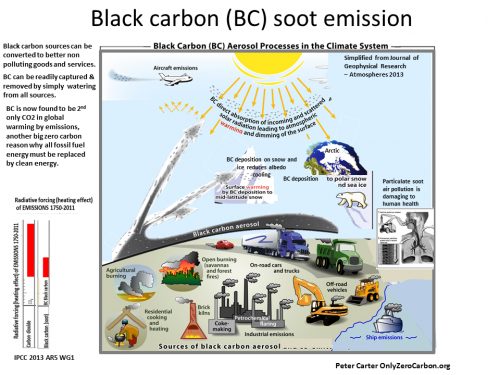
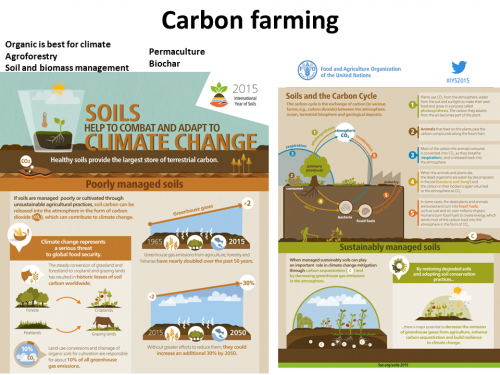
The best position on climate and CO2 (only) is the position of global civil society in the 2014 Climate Action Network International Position Statement.
The best published science response is the 2014 IPCC AR5 best-case scenario RCP2.6 (above right).
There is no response without terminating fossil fuel and other GHG polluting subsidies.
Nor without charging large central polluters the full social and environmental costs of their pollution.
The best published science response is the 2014 IPCC AR5 best-case scenario RCP2.6 (above right).
There is no response without terminating fossil fuel and other GHG polluting subsidies.
Nor without charging large central polluters the full social and environmental costs of their pollution.


Food production 30% emissions
From 2012 published research world food production is now responsible for 30% of global GHG emissions. This requires stopping forestation for agricultural land, conversion of the meat heavy diet and of chemical intensive agriculture. Because of unavoidable CO2 emissions from our best food production, the best we do with 100% of energy conversion is virtual zero carbon (90% reduction of CO2 emissions)
From 2012 published research world food production is now responsible for 30% of global GHG emissions. This requires stopping forestation for agricultural land, conversion of the meat heavy diet and of chemical intensive agriculture. Because of unavoidable CO2 emissions from our best food production, the best we do with 100% of energy conversion is virtual zero carbon (90% reduction of CO2 emissions)

OCEAN POWER The Oceans hold vast amounts of high energy dense power, by ocean thermal energy conversion WikiPedia conversion Paper OCEAN
The same applies to methane and nitrous oxide emissions.
A soil sink project SmartSOIL Europe
CONSTRUCTION CONVERSION Buildings world are being constructed of steel and concrete- nothing be be worse fo carbon emissions. Concrete is made by burning limestone- emitting CO2. All construction should and could be made of wood. 17 May 2017 Nature The wooden skyscrapers that could help to cool the planet
Jan 2018 Grist goes nuclear
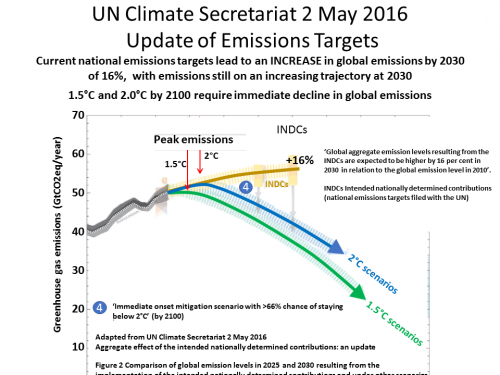
The Climate Mobililization Emergency City by city
Job One for Humanity Emergency Plan
Lester Brown Plan B4 (2010)
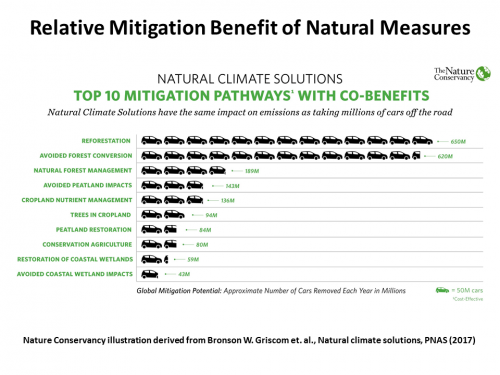
Sept 2017 Protect People and Planet from Extreme Climate Change, V. Ramananthan
2013 plan taken from J. Hansen et al, to protect young people future & nature
The Solutions Project
(M.Jacobson)
(M.Jacobson)
April 2018 Ecofys
100% decarbonisation
by 2050
100% decarbonisation
by 2050
Mission 2020
(Global emissions)
(Global emissions)
Sept 2018 1.5C Radical Realism for Climate Justice
IPCC Oct 2018 1.5C report:
Global emergency confirmed, global fossil fuel CO2 emissions decline by 2020
1.5ºC requires rapid, far reaching and unprecedented changes in all aspects of society, with clear benefits to people and natural ecosystems (media release) Black carbon (soot) and methane decline by 2023. Fossil fuel energy -86% by 2050
Big Hidden solutions
1.5ºC requires rapid, far reaching and unprecedented changes in all aspects of society, with clear benefits to people and natural ecosystems (media release) Black carbon (soot) and methane decline by 2023. Fossil fuel energy -86% by 2050
Big Hidden solutions
- Stop black carbon (soot) pollution (soot)
- Stop massive mainly southern hemisphere intentional forest burns- possibly half the CO2 emissions of all fossil fuel combustion., a lot of black carbon (soot) 2nd only to CO2 in warming, being emitted for thnese fires from such massive fires
- Stop draining tropical peatlands (high carbon) wetlands 10% the global fossil fuels emissions
Press release & Headline Statements, edited quick view
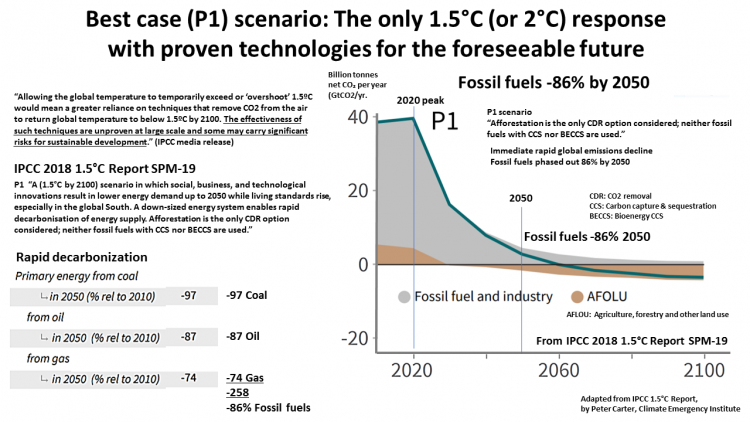
Our Children's Trust
Pathway Climate Recovery
Pathway Climate Recovery
Climate Action Plans Collection 2018
Climate Mobilization Emergency City plan e.g. San Francisco by J. Mitchell
'Shifting from a diet based on meat such as beef, lamb and dairy to other foods would reduce these emissions (i.e. food production emissions) by 70 percent (Options for keeping the food system within environmental limits, 2018).
A decade to end fossil fuels 2016 study
Citiesalone cover 2% of global land but are responsible for 70% of emissions (UN Habitat)
The rich wealthiest 10% in the world are responsible for almost 50% of emissions, which applies across countries. That requires a personal carbon tax on the rich.
Terminate the planet destroying fossil fuel subsidies.
Tax carbon at the wellhead.
ZERO COMBUSTION ENERGY (=zero CO2, black soot, methane from fugitive natural gas emissions-and coal)
Zeroing our TRANSPORTATION. No more roads, runways, fossil fuel planes or ships.
Electrification must be only from zero combustion energy.
Zeroing our TRANSPORTATION. No more roads, runways, fossil fuel planes or ships.
Electrification must be only from zero combustion energy.
ZERO COMBUSTION (broadcast burning) AGRICULTURE (CO2, black carbon)
ZERO TROPICAL DEFORESTATION & convert to WOOD CONSTRUCTION SINK CARBON
ZERO MEAT and DAIRY (methane and nitrous oxide from cattle and dairy industries, CO2 from deforestation (for cattle)
ZERO FOSSIL FUEL SUBSIDIES, ZERO EXTERNALIZING (avoiding socio-environmental costs) & ZERO FUTURE DISCOUNTING
ZEROING FOR GLOBAL SURVIVAL
These are all CONVERSIONS from GHG polluting sources to well known 'alternatives'
MOVING TO ZERO CHEMICAL REGENERATIVE AGRICULTURE (nitrous oxide, carbon retention) -but warming soils emit more carbon.
Food: An appetite for destruction 25 Feb 2019 Nature
16 March 2019Our wooden future
To sustain this rate of emissions reduction and to drop atmospheric CO2 for survival requires a 10 year Apollo, Manhattan, Marshall project for a 100% rapid clean energy world rebuild and massive safe CO2 air removal
Must Stop Arctic sea ice loss- amplifying feed-back Here's how?
"Annual emissions from fossil fuels must start falling by 2020"
June 2019 What Can I Do?
Nukes for survival Advanced more powerful and safe nuclear fission reactors are essential source of energy dense zero carbon power (China leads 2018 VIDEO)
LAND DEGRADATION Rene Castro Salazar, UN Food and Agriculture Organization, tells that almost half of the 5 billion acres of land around the world that have been degraded by human factors and could be restored at a cost of $300 billion and give 20 years of absorbing more carbon. At least a third of the world’s land has been degraded to some extent, directly affecting the lives of 2 billion people, says E. Mansur, director of the land and water division at the FAO.
Global solar atlas 2019
Global wind atlas 2019 (World Bank)
UNEP 2019 Emissions GAP Report (short version) "On the brink of 2020, we now need to reduce emissions by 7.6 per cent every year from 2020" to 2030. Interactive visual
News Report in brief Full 2019 GAP Report UNEP GAP VIDEO
UNEP 2019 GLOBAL EMISSIONS MUST DROP 7.6% EACH YEAR STARTING 2020
Direct CO2 air capture
Jan 2020 We Need a Massive Climate War Effort—Now Only major spending on clean energy R&D can save us
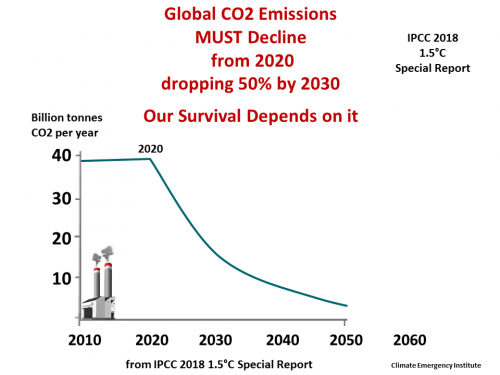
IPCC 1.5C Report
2019 fossil fuel 53 orgs Lofoten Declaration
Immediate rapid acting emergency measures. Stop fossil fuel subsidies. Stop deforestation. Stop non-essential manufacturing. World diet to vegan. Wetland rice switched to dry-land grains. Massive global tree plant.
2017 Why global emissions must peak by 2020 Real Climate Expert site

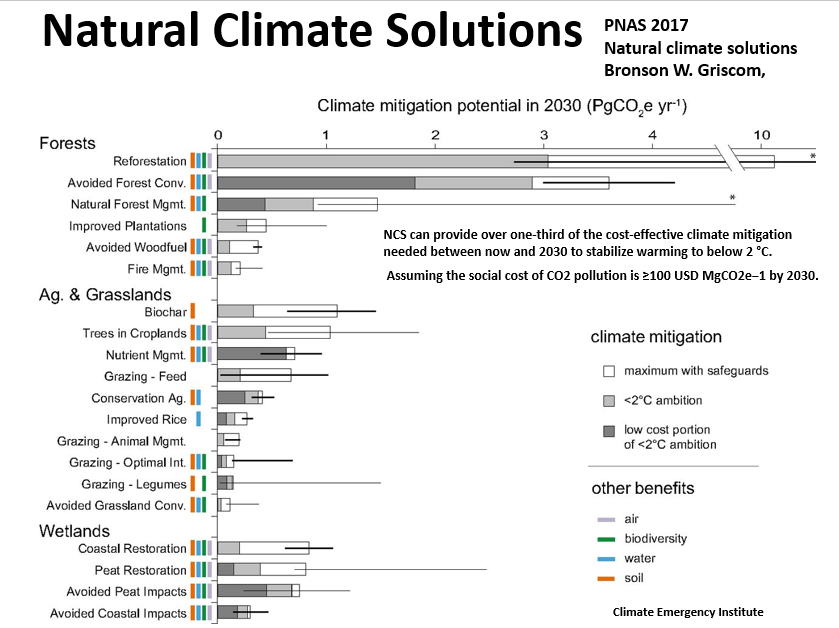
The root cause of climate disruption is The perverse world ECONOMY 2020 Oscar Reyes, Change Finance, not the Climate Handbook
2006 David Wasdell original Apollo climate project
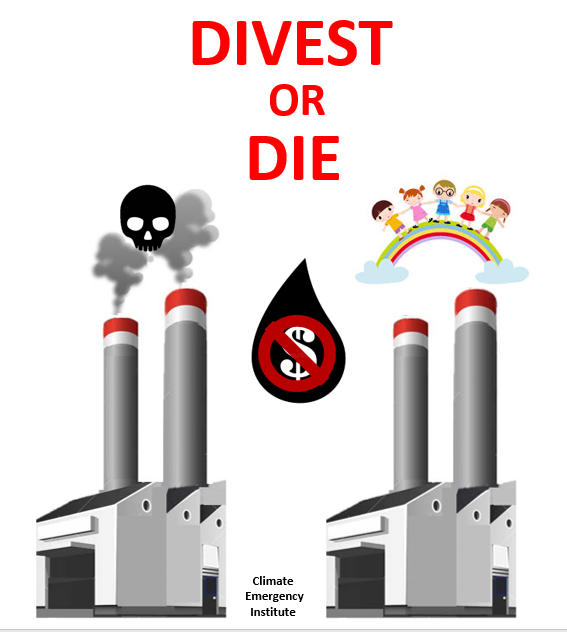
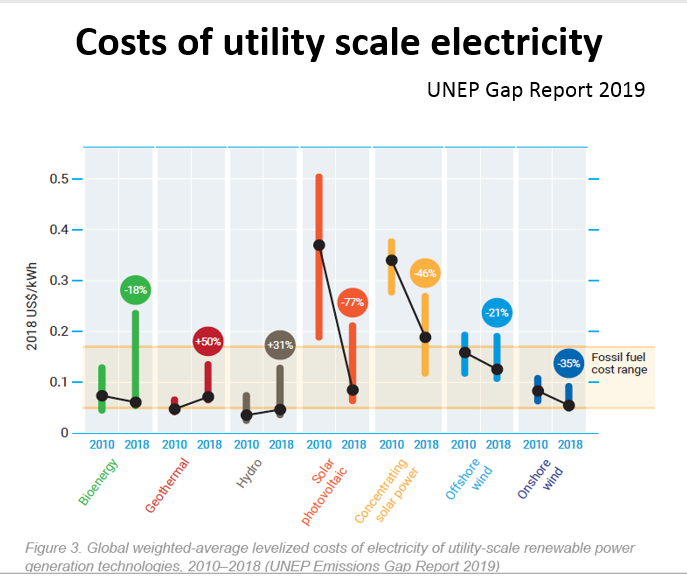
High energy dense green hydrogen power is an essential
component of the zero carbon economy
component of the zero carbon economy
VIDEO 2019 IPCC Chair H. Lee says
emissions decline immediately
emissions decline immediately